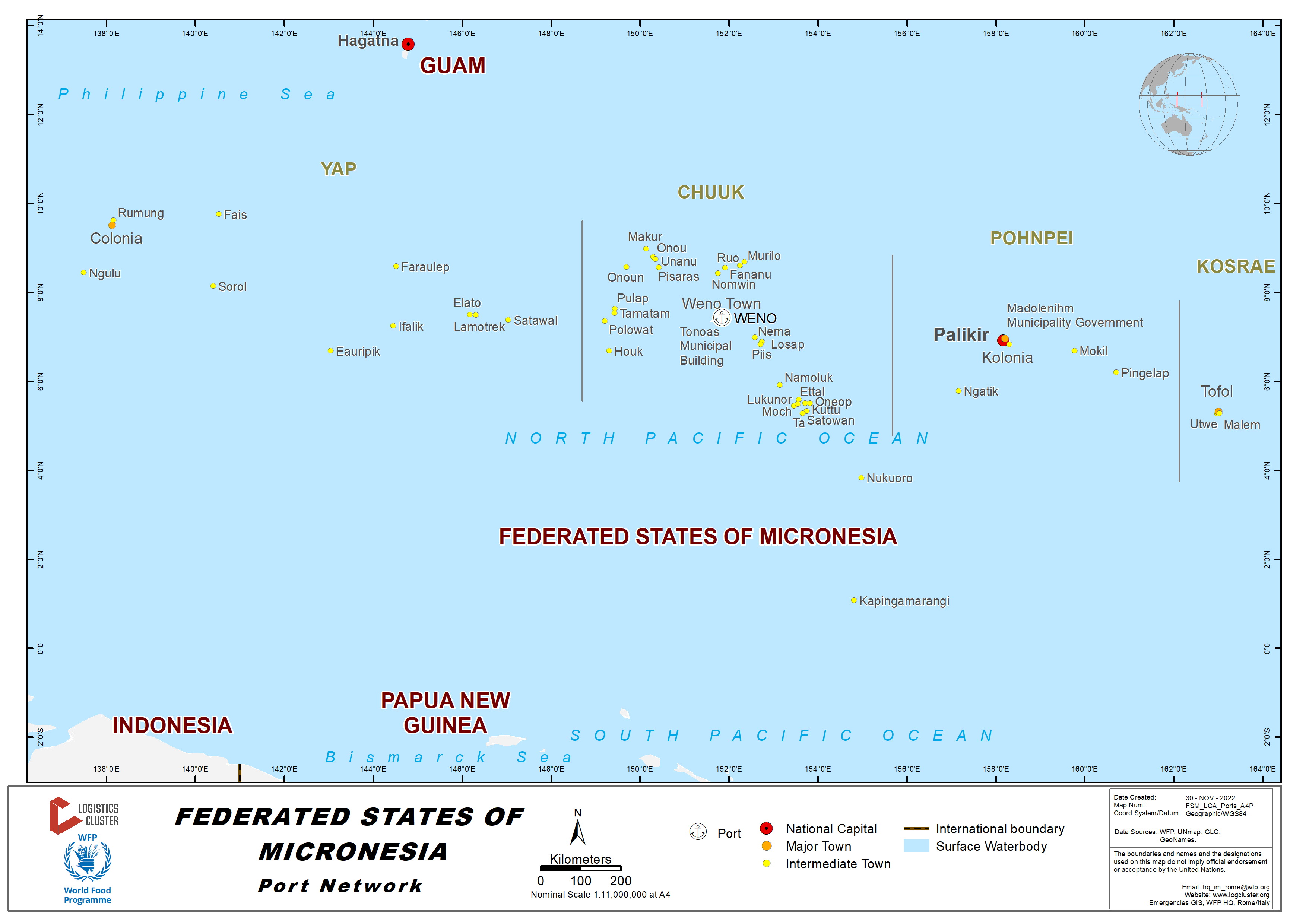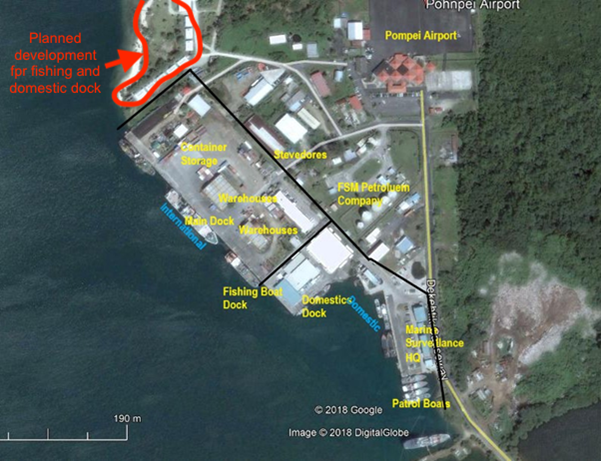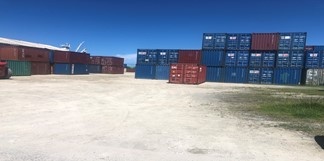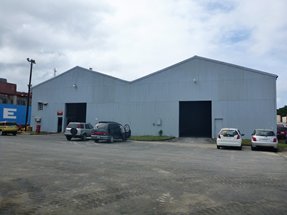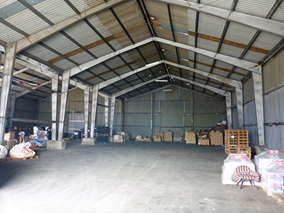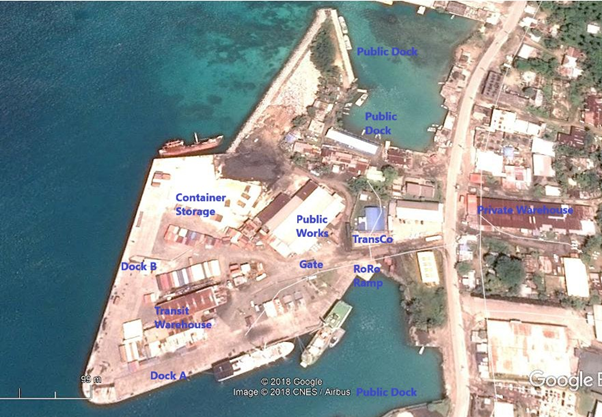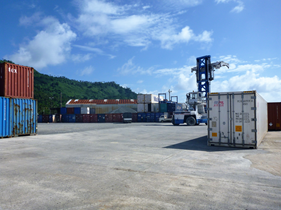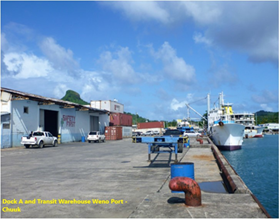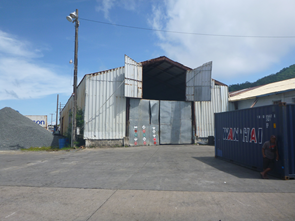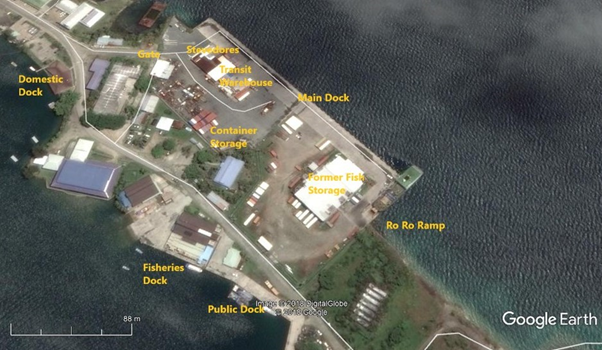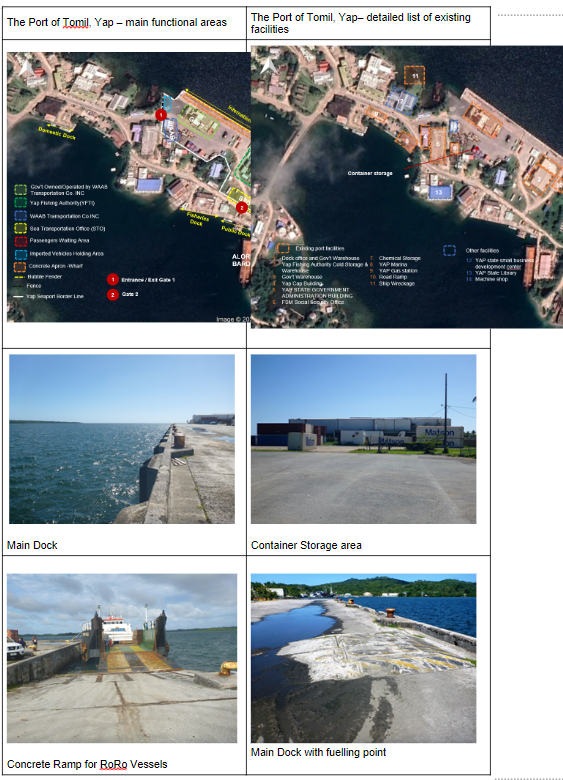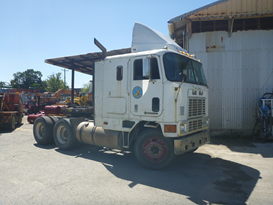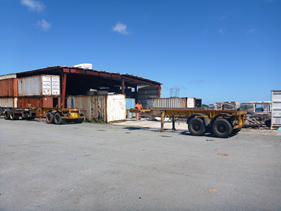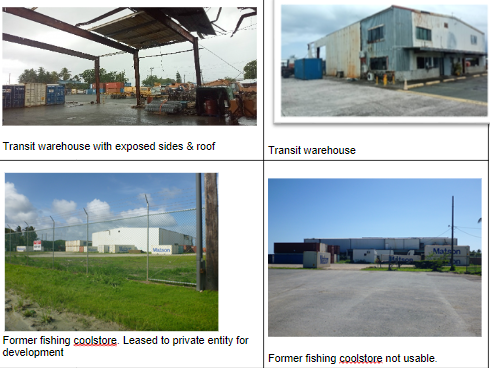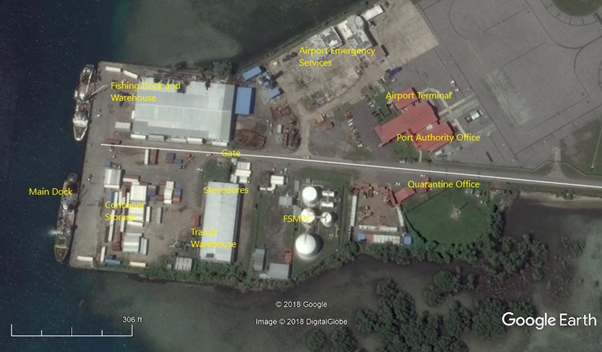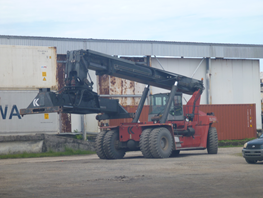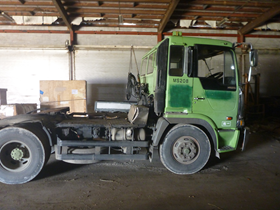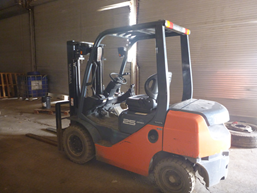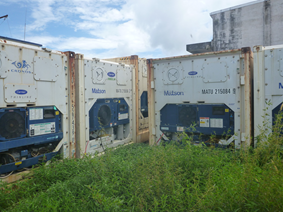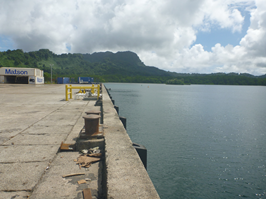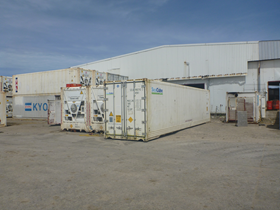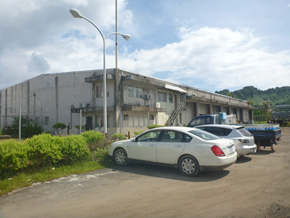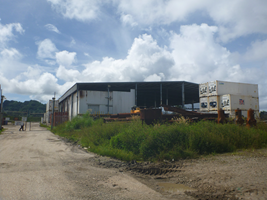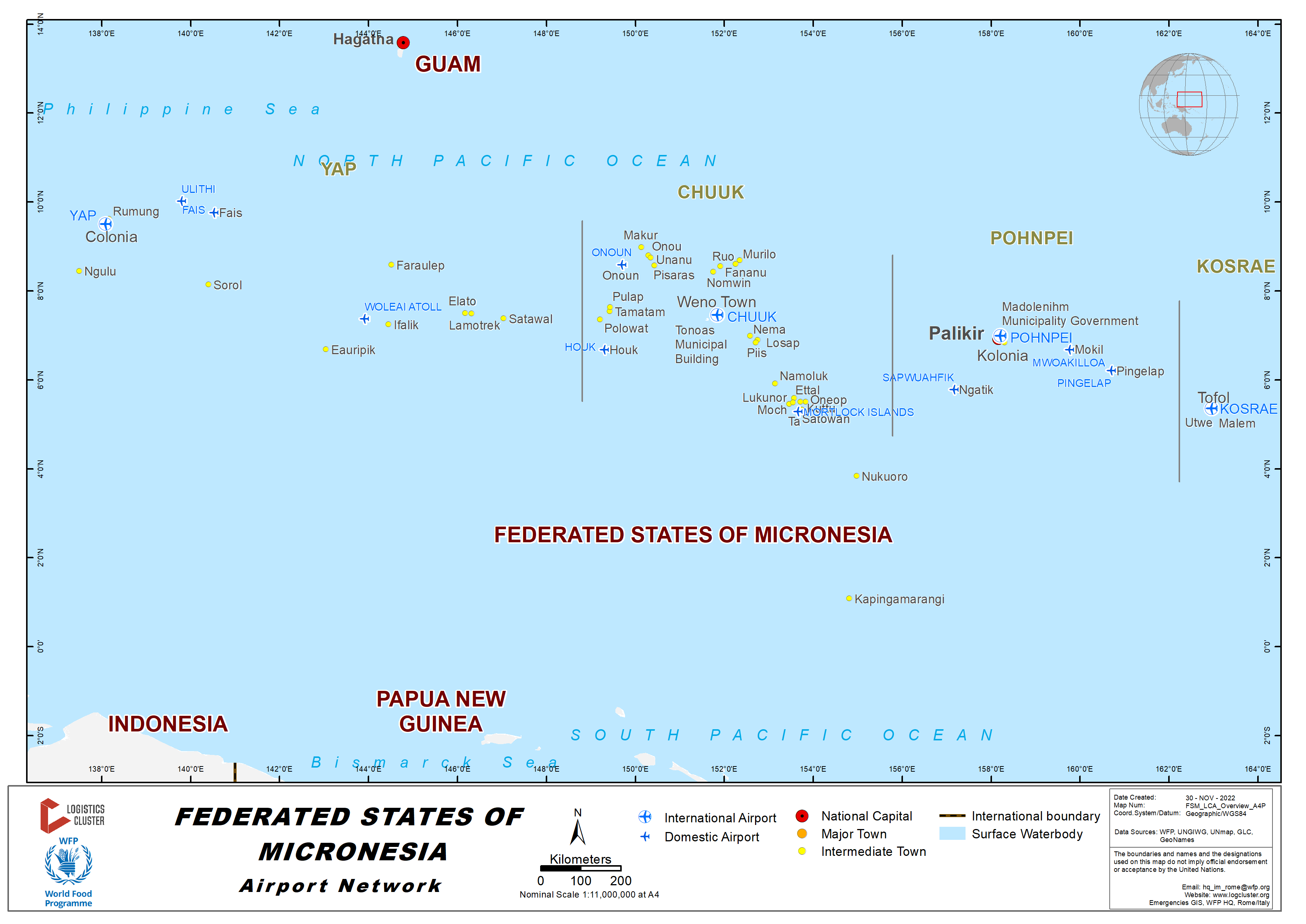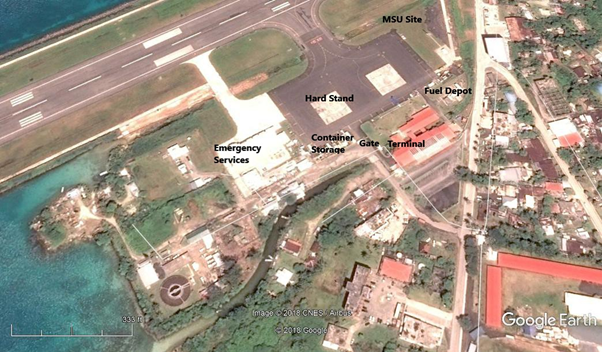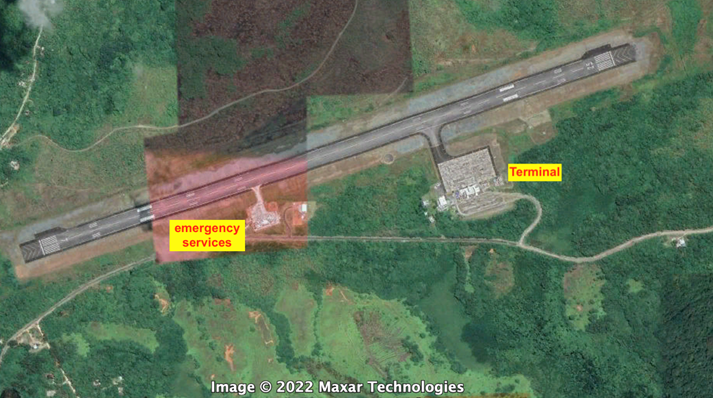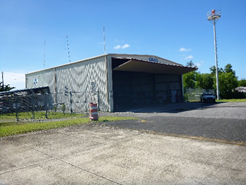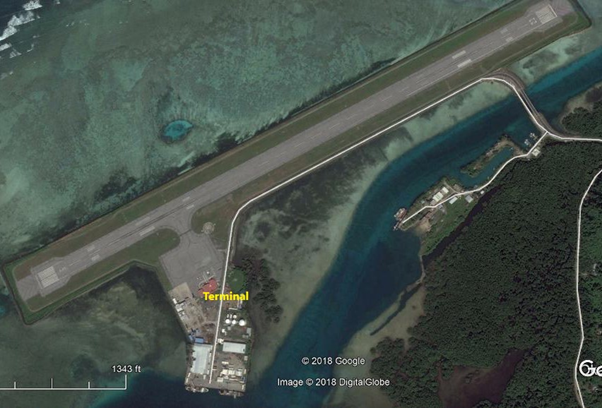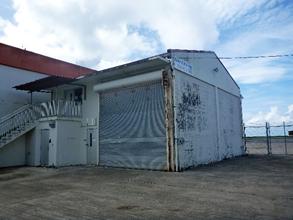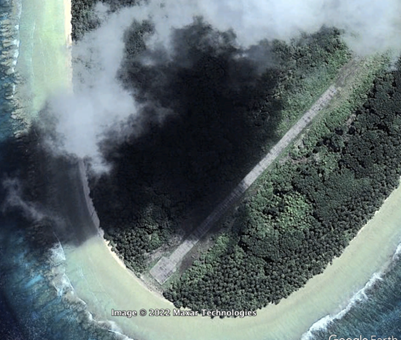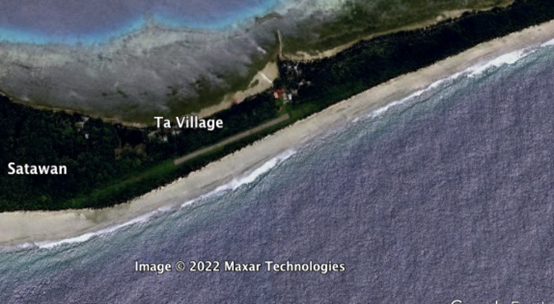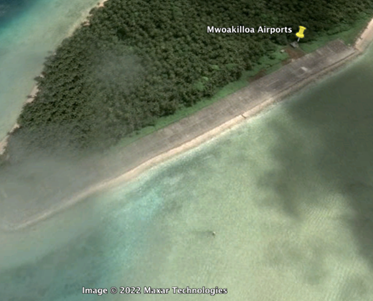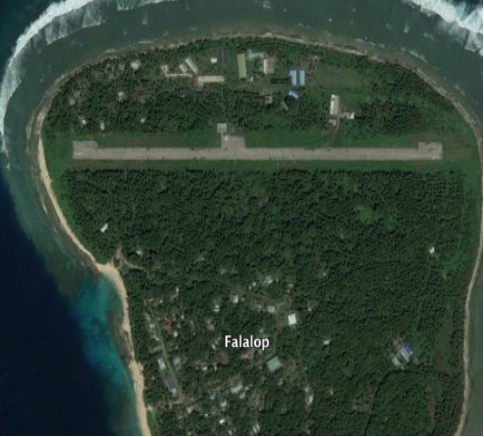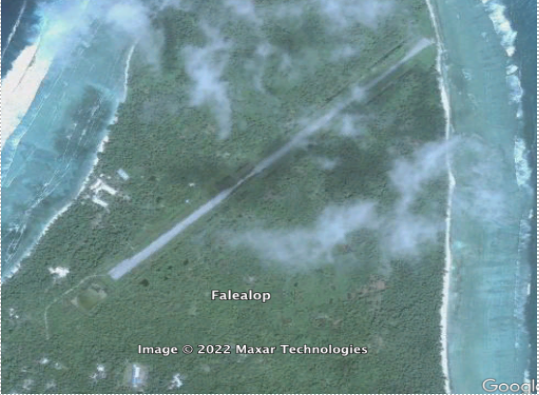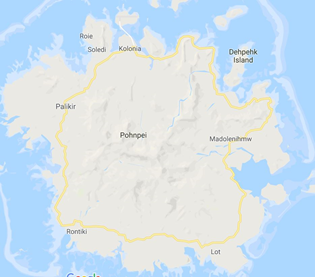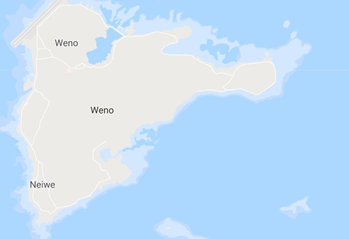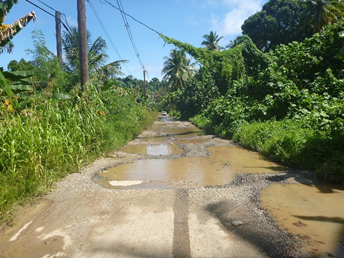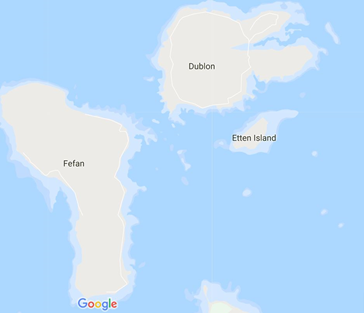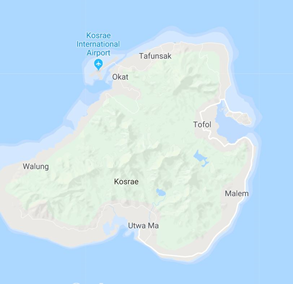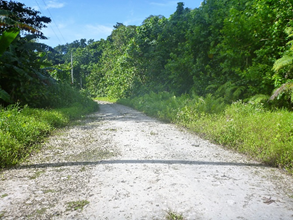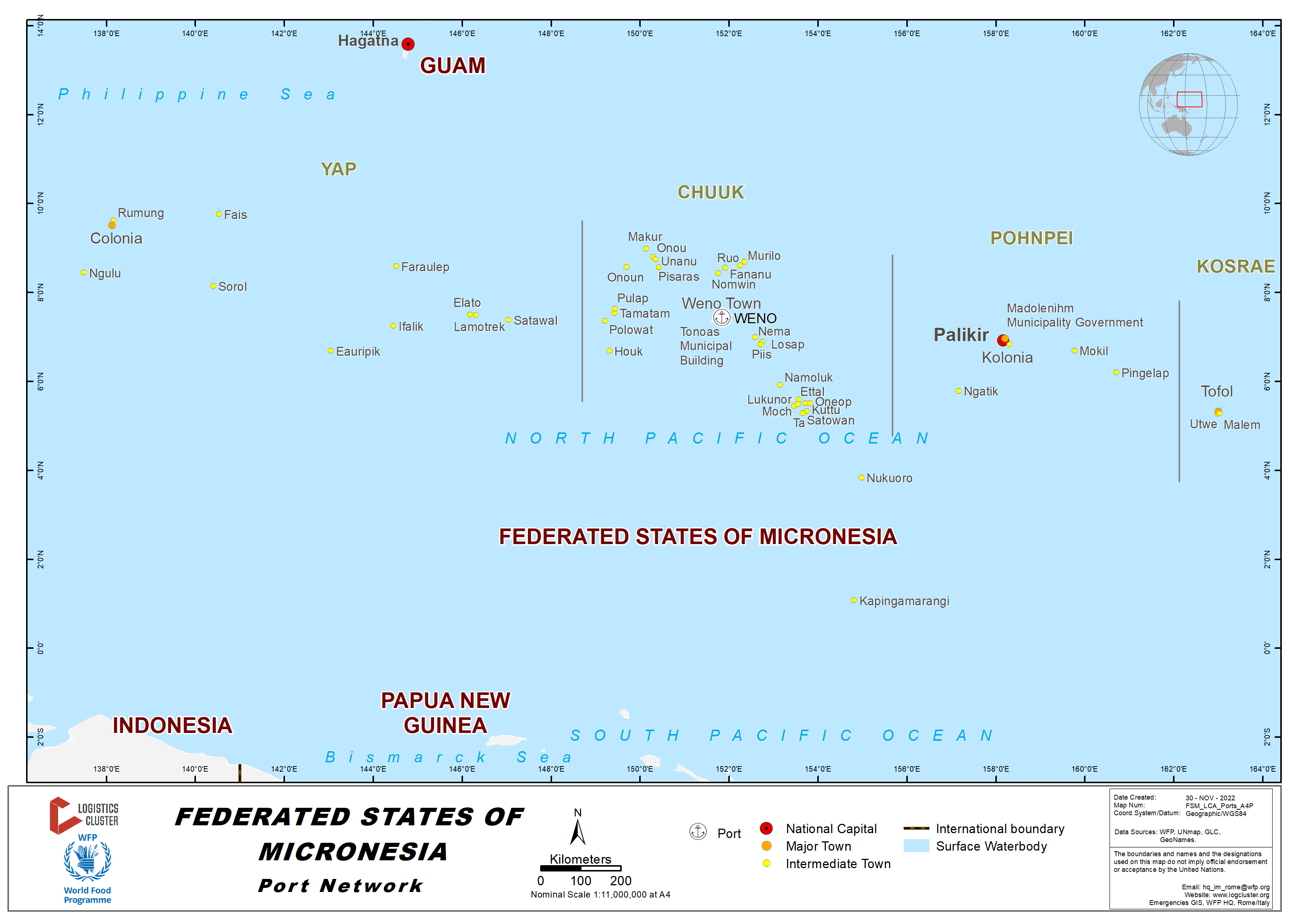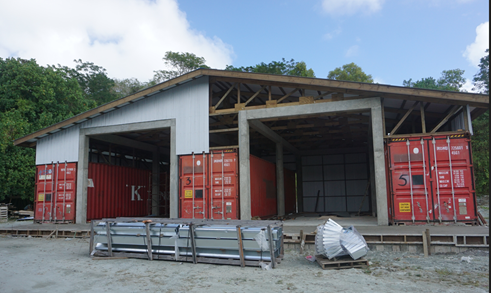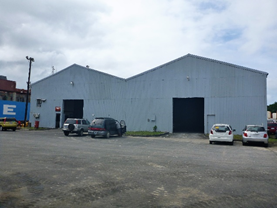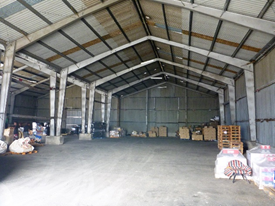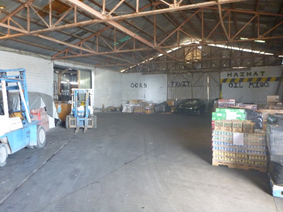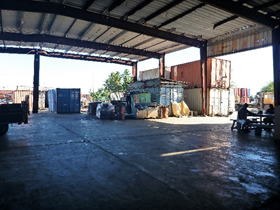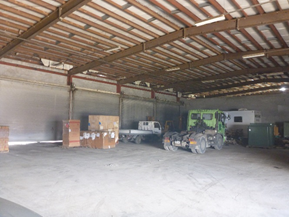2 Micronesia Logistics Infrastructure
Most large infrastructure and utilities services are supported by either FSM or State Governments. Services such as electricity supply, fuel supply, roads, ports and airports are all government owned and managed, although private contractors manage some of the services such as stevedoring and freight handling
Other than in the state capitals few retail and business services exist. Almost all goods are imported into FSM except for fish and coconut products. The retail and business sector relies on the import of goods from China, Taiwan, Korea, the United States and Australasia.
The retail sector consists on several multi sectored supermarkets providing items from food, clothing kitchenware, white goods, sport goods, office supplies and hardware. There are a limited number of larger, locally owned retail outlets.
There is a total reliance on imported goods. Goods are relatively expensive and small local convenience stores are scattered throughout the communities supplying small items for daily use.
Small entrepreneurs operate niche services and stores based on importing goods ranging from computers, clothing, stationary supplies and boat motors, to beer, to engine oil.
There are a number of National and State projects underway to upgrade port and airport infrastructure with support from various external organisations such as the World Bank, Asian Development Bank, Japan and USA governments. Completion dates range from 2 to 5 years and are aimed at enhancing the current internal logistics infrastructure.
2.1 Micronesia Port Assessment
Micronesia operates four international seaports, one in each state: Pohnpei, Chuuk, Yap and Kosrae.
In Pohnpei and Yap the ports are managed by a Port Authority while in Chuuk and Yao the ports are operated through the Department of Transport and Public works. All four ports are in a protected Lagoon environment
All ports are general ports and almost exclusively all in-bound and out-bound freight is containerised. While this is the case no wharf unloading container facilities exist other than a single 50 mt mobile crane in Pohnpei Port. All vessels visiting Micronesia's ports must have gantry cranes for loading and unloading.
All ports have top Loaders or reach stackers for moving and stacking containers once unloaded. Most equipment is in serviceable condition. Small numbers of key handling assets create a vulnerable point to reliable goods handling in the case of emergency.
In Pohnpei Port planning is well advanced to extend the current port footprint to increase container storage space and provide additional berthing to accommodate the fishing fleet and domestic shipping. This will allow dedicated berthing for international freight services. Estimated completion is two years.
2.1.1 Micronesia Port of Pohnpei
Port Overview
The Port of Pohnpei is located on the island of Pohnpei. Pohnpei is the capital of the Federated States of Micronesia and the National government is established in Palikir, Sokehs. The Port is operated by the Pohnpei Ports Authority and along with all other ports in FSM is overseen by the Department of Transportation Communication and Infrastructure. The port predominantly facilitates the import of goods for domestic use which is almost exclusively containerized freight.
The port is broken into four separate areas: International, Fishing, Domestic and Marine Surveillance.
The main dock encompasses the international and fishing dock with the domestic and marine surveillance dock adjacent to the main dock area.
Port website: http://www.ppa.fm
Key port information can also be found at: http://www.maritime-database.com
|
Port Location and Contact |
|
|---|---|
|
Country |
Federated States of Micronesia |
|
Province or District |
Pohnpei |
|
Nearest Town or City with Distance from Port |
Kolonia 2.5km |
|
Port's Complete Name |
Pohnpei Harbour |
|
Latitude |
6.979400 |
|
Longitude |
158.201225 |
|
Managing Company or Port Authority |
Pohnpei Port Authority |
|
Management Contact Person |
Grilly Jack |
|
Nearest Airport and Airlines with Frequent International Arrivals/Departures |
Pohnpei International Airport, adjacent to the Port United Airlines |
Port Picture
- International and Domestics Docks
- Fishing Boat Dock
- Warehouses
- Container Storage
- Stevedores
- Marine Surveillance Head Quarters
- Patrol Boats
- Pohnpei International Airport
Main dock
Description and Contacts of Key Companies
The Pohnpei Port Authority in addition to overall responsibility for all ports, airports and airfields throughout Pohnpei State handles the port terminal services. Stevedoring Services are provided by Federated Shipping Company (FSCO) a private company that undertakes all freight movements at the port as well as handling warehousing and storage of goods, piloting services and the delivery of containers and goods to site.
For more information on port contacts, please see the following link: 4.4 Micronesia Port and Waterways Companies Contact List.
Port Performance
The port handles approximately 3-5 cargo vessels per month almost exclusively container freight with Matson and Kyowa line providing scheduled services to Pohnpei. The port also receives bulk fuel vessels 2-3 times per month. The port handles approximately 80 containers of freight per month. The dock is situated inside a lagoon on the Northern side of Pohnpei.
The international dock is physically adjacent to the fishing and domestic dock, separated by a security fence.
Containers must all be unloaded by vessel gantry crane as no dockside container cranes or equipment are available at the dock. There is a 50MT mobile crane in the container storage area. Containers can generally be unloaded at 4-6 per hour.
The international port is not congested but the limited amount of handling equipment available could leave the port vulnerable in times of high need. The port handling equipment is in good condition. Adjacent to the international dock, at the southern end, is the fishing dock where tuna fishing vessels berth
Tuna fishing is the major export from FSM. In Pohnpei, transhipment is conducted at the anchorage area. After transhipment, fishing vessels proceed to the dock for provisioning, bunkering, maintenance and net repairs. At times fishing vessels berth 3 abreast causing congestion. All tuna fishing activities are privately operated.
The domestic dock lays south of the fishing dock and is the home base of the two FSM government owned freight and passenger vessels: the MV Caroline Voyager and the MV Micronesian Navigators. When both vessels are in port, due to space constraints, they are required berth side by side.
|
SEASONAL CONSTRAINTS |
||
|---|---|---|
|
Occurs |
Time Frame |
|
|
Rainy Season |
Yes |
November to April but does not affect operation unless severe event |
|
Major Import Campaigns |
No |
|
|
HANDLING FIGURES for 2022 |
|
|---|---|
|
Vessel Calls |
154 as of August 2022 |
|
Container Traffic (TEUs) |
1,683 as of August 2022 |
|
Handling Figures Bulk and Break Bulk for 2022 |
|
|---|---|
|
Bulk (MT) |
N/A |
|
Break bulk (MT) |
53,476.47 as of August 2022 |
Discharge Rates and Terminal Handling Charges
For information on port rates and charges, please see the following table:
|
Terminal Handling charges |
Cost USD |
Comments/ source |
|
Discharge/ Load |
9.24/ W/MT |
Association of Terminal Operators & Stevedoring Companies of Micronesia |
|
Discharge/Load Container 20’ w/cargo |
38.50/ movement |
|
|
Discharge/Load Container 40’ w/cargo |
42.35/ Movement |
|
|
Discharge/Load Container empty |
24.26/ Movement- 20’footer container 61.60 / Movement- 40’ footer container |
|
|
Straddle Carrier/Fork Under hook to yard or vis a versa |
20’ 15.40 /Movement 40’ 61.60 Movement |
|
|
Stuffing and unstuffing containers |
6.36/W/Mt |
|
|
LCL Bulk break goods unloading/loading International |
6.16/W/Mt |
|
|
Bulk break goods Domestic shipping |
12.63/W/MT |
|
|
Demurrage General freight Refrigerated fright |
5 Days No free time |
|
|
Demurrage charges Bulk break fright |
1.50/W/MT/Day Inside the Warehouse 1.00/W/MT/Day Outside the warehouse & unprotected |
|
|
Delivery |
||
|
Deliver/Return of containers to site |
$ 50.00 – Empty container $ 69.00 – Full container |
|
|
Port Fees |
|
Pohnpei Port Authority Seaport Rules & Regulations |
|
Entry fee:
|
$50.00 $0.06 per gross registered ton (grt) |
|
|
Dockage fee |
~ 0 up to 100 feet $35.00 ~ 101 up to 150 feet $50.00 ~ 151 up to 200 feet $60.00 ~ 201 up to 250 feet $95.00 ~ 251 up to 300 feet $115,00 ~ 301 up to 350 feet $155.00 ~ 351 up to 375 feet $215.00 ~ 376 up to 400 feet $255.00 ~ 401 up to 425 feet $265.00 ~ 426 up to 450 feet+ $285.00 ~ 451 up to 475 feet $305.00 ~ 476 up to 500 feet $355.00 ~501 feet up $405.00 |
|
|
Handling charges |
|
|
|
Aids to Navigation dues per port call |
$0.02 per grt |
|
|
Supplemental Port Services Fee |
|
|
Berthing Specifications
|
Type of Berth |
Quantity |
Length (m) |
Maximum Draft (m) |
Comments |
|---|---|---|---|---|
|
Conventional Berth |
1 |
264 70 60 |
12 |
International dock FIshing dock Domestic dock |
|
Container Berth |
No |
|
||
|
Silo Berth |
No |
|
||
|
Berthing Tugs |
No |
|
||
|
Water Barges |
No |
|
General Cargo Handling Berths
|
Cargo Type |
Berth Identification |
|---|---|
|
Imports - Bagged Cargo |
N/A |
|
Exports - Bagged Cargo |
N/A |
|
Imports and Exports - RoRo |
N/A |
|
Other Imports |
Vehicles |
Port Handling Equipment
The port equipment is owned and operated by Federated Shipping Company Ltd (FSCO) - a privately owned operator. The handling equipment is in good working condition with top loaders and large forklifts available.
Smaller forklifts are used for movement of palletized freight and are in good working condition. One mobile crane (50MT) has just been purchased and also available.
The top loaders move all containers from dockside to storage and load all tractor trailers for delivery. Consignees can also unload containers in the storage area in lieu of delivery
There are no tugmasters, and all containers are stacked and loaded directly on the container chassis by top loader. Containers chassis for 20 footers and 40 containers are available
FSCO maintains three prime movers/tractor for container delivery.
|
Equipment |
Available |
Total Quantity and Capacity Available |
Comments on Current Condition and Actual Usage |
|---|---|---|---|
|
Dockside Crane |
No |
||
|
Container Gantries |
No |
||
|
Mobile Cranes |
Yes |
1 x 50MT |
New |
|
Reachstacker |
Yes |
1 x 40 MT 1 x 30MT |
Operational |
|
RoRo Tugmaster (w/ Trailer) |
No |
||
|
Grain Elevator w/ Bagging Machines |
No |
||
|
Transtainer |
No |
||
|
Forklifts |
Yes |
1 x 28 MT 1 x 25 MT 1 x 12 MT 1 x 5 MT 1 x 4 MT 1 x 2 MT |
All operational |
|
Tractor unit single axle |
Yes |
1 |
operational |
|
Tractor unit double axle |
Yes |
1 |
operational |
50 mt crane
Reach stacker
Container Facilities
While almost all freight moving through the port is in containers the port has no dedicated container facility and operates as a general port.
|
Facilities |
20 ft |
40 ft |
|---|---|---|
|
Container Facilities Available |
N/A |
N/A |
|
Container Freight Station (CFS) |
N/A | N/A |
|
Refrigerated Container Stations |
Located at fishing dock. For private use. |
|
|
Other Capacity Details |
Storage space up to 800 containers | |
|
Daily Take Off Capacity |
7 | 4 |
|
Number of Reefer Stations |
17 connections point owned by a private fishing company (Luenthai Fishing Venture building adjacent to yard) | |
|
Emergency Take-off Capacity |
Dependent on vessel's capacity |
|
|
Off take Capacity of
Gang Shift |
25 | 15 |
Customs Guidance
As with all states in the FSM Customs is nationally controlled and regulated through the Department of Finance and Tax Administration. DFTA Customs officers are based in each state capital and attend the port upon the arrival of each vessel. Attendance at the port is dependent on the shipping arrivals schedule otherwise customs is located at the Government administration buildings between 8am-5pm Monday to Friday
Standard shipment documentation is required to clear customs and is processed at the port at state level. For tax and duty exemption the procedure is to obtain the exemption letter for humanitarian goods through DECEM and the Department of Transport and Infrastructure in Palikir and for such an exemption letter to be provided with the clearance documentation at the port level, ideally prior to the arrival of the shipment.
Clearance time for consignment is 24-48 hours and humanitarian goods will be prioritized in an emergency provided correct documentation is complete
For more information on customs in the Federated States of Micronesia, please see the following link: 1.3 Micronesia Customs Information.
Terminal Information
Multipurpose Terminal
Pohnpei Port is essentially a general terminal and all vessels must be compatible and equipped with the ability to load and unload i.e. Gantry cranes for containers or bulk break or bagged or ramped vessels for vehicle loading on to the flat dock.
There are three dock areas. International, Fishing Dock and the Domestic dock.
The Marine Surveillance dock lies adjacent to and south of the Domestic dock.
Grain and Bulk Handling
None
Main Storage Terminal
Pohnpei Port has two storage areas dock side. Two transit warehouses for bulk break freight and outside container storage
|
Storage Type |
Number of Storage Facilities |
Area (m2) |
|---|---|---|
|
Bagged Cargo |
Pohnpei Port has two storage areas dock side. 2 transit warehouses for bulk break freight and outside container storage |
570 m2 1,140 m2 |
|
Refrigerated Cargo |
Reefer containers only. Private (fishing company) chillers adjacent to dock area |
|
|
General Cargo |
1. Outside area container and vehicle storage 2. Warehouses as Dockside for Bulk break freight. |
7,500 m2 7,500 m2 |
|
|
|
|
Storage and Transit Warehouses |
Floor Storage |
Stevedoring
While the port operation falls under the Pohnpei Ports Authority, a single private company provides stevedoring services the Federated Shipping Company Ltd (FSCO). FSCO also undertakes all terminal services and local transport services. FSCO Offices are located adjacent to the dock area on the access road (refer map)
All ships operating at the port require gantry cranes to load/unload container freight. The Kyowa line uses RoRo vessels for the shipment of vehicles, which also fall under the responsibility of FSCO.
Stevedoring services are mechanical as are terminal services and the labour component is for the unstuffing of containers. During an emergency additional labour can be provided by FSCO.
Hinterland Information
FSCO provides distribution services through the use of container chassis. Containers are delivered to customers and dropped at the consignee’s site. Consignees have 5 days after vessel departure to unload containers. FSCO own 3 x prime mover /tractor and 20 trailers.
Private companies also operate their own tractors and trailers for collection of containers. Due to the limit on FSCO trailer availability it is often the case that containers and trailers are only returned on the day of the next vessels arrival whether this is outside the free period of not. As such demurrage is often not charged to regular customers
Port Security
Micronesia is not signatory to the ISPS Code, however, the U.S. has invested resources to assist the Federated States of Micronesia build the capacity to implement the ISPS Code to increase merchant trade.
Pohnpei Port operates under ISPS guidelines and has not recently undertaken an ISPS inspection due to the COVID-19 pandemic. As for previous inspection, the results are unknown at the time of writing. There was verbal acknowledgment from the Port Manager of some minor breaches that are difficult to rectify. The main issue is the location of a multi-story hotel that is adjacent to and overlooks the fence into the Commercial Port. To meet ISPS requirements the removal of the hotel is required. This is in the planning process and the site will ultimately accommodate a dock extension for use by the fishing fleet and domestic shipping. Timeline for this is 2-3 years.
|
Security |
|
|---|---|
|
ISPS Compliant |
Yes with current breaches |
|
Current ISPS
Level |
Level 1 |
|
Police Boats |
Yes -2 Patrol boats operated by the FSM Maritime Surveillance and Border Control |
|
Fire Engines |
Aircraft, Fire Fighting & Rescue (ARFF) stationed at airport adjacent. Fire Emergency stationed in town. |
2.1.3 Micronesia Port of Chuuk
Port Overview
The port of Weno is operated through the State government Department of Transport and Public works who has responsibility for both the seaports and airports throughout Chuuk.
The port consists of two main docks and hosts both Intentional and domestic shipping.
Freight through the terminal is almost exclusively container freight with the exception of vehicles. No bulk break cargo is moved unless it is in an LCL containers bulk or bagged commodities are received or handled internationally. Bulk break goods are however handled on domestic shipping legs.
Chuuk (formerly Truk) lagoon has a significant maritime history being the service port for Japanese fleet during WW2. As such the access and shelter provided to ships including aircraft carriers is historically easily accommodated.
Port website: http://www.ict.fm/transportation-marine.html
Key port information can also be found at: http://www.maritime-database.com
|
Port Location and Contact |
|
|---|---|
|
Country |
Federated States Of Micronesia |
|
Province or District |
Moen |
|
Nearest Town or City with Distance from Port |
Weno 1 Km |
|
Port's Complete Name |
Port of Chuuk |
|
Latitude |
72645.52 N |
|
Longitude |
1515023.61 E |
|
Managing Company or Port Authority |
Dept Transport and Public Works |
|
Management Contact Person |
John Smith Port Manager |
|
Nearest Airport and Airlines with Frequent International Arrivals/Departures |
Chuuk International Airport Air Nugini United Airlines |
Port Picture
Description and Contacts of Key Companies
The port terminal services and stevedoring is handled by a private company Transco. Piloting services are handled by private operators.
Chuuk Department of transport and Public works are responsible for the administration and regulations of Weno Port. However all port operations are contracted out to private companies.
Transco are the main contractors and are responsible for all terminal services and stevedoring. Piloting services are available through Transco through a subcontracted pilot.
For more information on port contacts, please see the following link: 4.4 Micronesia Port and Waterways Companies Contact List
Port Performance
The port itself handles approximately 5 cargo vessels per month almost exclusively container freight with Matson and Kyowa line providing scheduled services to Chuuk. The dock is situated on Weno Island inside Truk lagoon and access is via channels through the outer reef. With 2 docks 190m and 185M long the largest vessel accommodated at the dock was 13000 tons. Larger ships may anchor in the lagoon.
Containers must all be unloaded by Gantry crane as no container cranes are available at the dock. Depending on ships gantry crane capacity. Containers can generally be unloaded at 6-10 per hour.
The port is not congested but the limited amount handling equipment used on the port could leave the port vulnerable in times of high need. Port handling equipment was in good condition but only a small number were available.
|
SEASONAL CONSTRAINTS |
||
|---|---|---|
|
Occurs |
Time Frame |
|
|
Rainy Season |
Yes |
November to April but does not affect operation unless severe event |
|
Major Import Campaigns |
No |
|
|
Other Comments |
|
|
|
HANDLING FIGURES for 2017 |
|
|---|---|
|
Vessel Calls |
60 per year |
|
Container Traffic (TEUs) |
750 per year |
|
Handling Figures Bulk and Break Bulk for 2017 |
|
|---|---|
|
Bulk (MT) |
None |
|
Break bulk (MT) |
Approx 150-200 MT/Year |
Discharge Rates and Terminal Handling Charges
For information on port rates and charges, please see the following table:
|
Terminal Handling charges |
Cost |
Comments/ source |
|
Entry |
10c/GRT |
Transco |
|
Anchorage |
USD150/24hrs |
Transco |
|
Dockage/Berthing |
USD 0.7cGRT/24hrs |
Transco |
|
Wharfage Load/Unload |
10c/GRT |
Transco |
|
Bulk break |
USD 1.75/m3 |
Transco |
|
Customs |
4% of CIF |
Transco |
|
Demurrage after 10 days Dockside |
20’ USD 62.10/day +5% state tax 40’ USD 124.20/day +5% state tax |
Transco |
|
Clearance |
||
|
Shipping Agent Handling charges for customs clearance only. |
USD52.50 10% of 4% CIF |
Transco |
|
Storage Bulk break freight |
USD 2.30/m3 |
Transco |
|
Shipping Agent handling charges for clearing containers |
20’ USD 210 40’ USD 425 |
Transco |
|
Delivery |
||
|
Delivery of containers to site |
20’ USD 189 40’ USD 217 |
Transco |
|
Demurrage is charged after 3 days at the following rates |
20’ USD65.21/day 40’ USD130.41.20/day |
Transco |
|
Container moving/loading unloading to site outside dock |
Tractor rental USD 175/hr Trailer Rental USD50/hr 2 forklifts required to unload empty container USD183/hr |
Transco |
Berthing Specifications
|
Type of Berth |
Quantity |
Length (m) |
Maximum Draft (m) |
Comments |
|---|---|---|---|---|
|
Conventional Berth |
2 | 180 and 190 | 9 |
|
|
Container Berth |
no |
|
||
|
Silo Berth |
no |
|
||
|
Berthing Tugs |
no |
|
||
|
Water Barges |
|
A concrete RoRo ramp available for front ramp vessels including landing craft.
General Cargo Handling Berths
|
Cargo Type |
Berth Identification |
|---|---|
|
Imports - Bagged Cargo |
NA |
|
Exports - Bagged Cargo |
NA |
|
Imports and Exports - RoRo |
NA |
|
Other Imports |
Vehicles |
Port Handling Equipment
The port equipment is owned and managed by Transco - a private operator. The handling equipment seen was in good condition although only single top loader is available. Smaller forklift for movement of palletised freight are available and in fair condition.
The top loader moves all containers from dockside to storage and loads all tractor trailers for delivery. Consignees can also unload containers in the storage area in lieu of delivery
There are no tug masters and all containers are stacked and loaded directly upon the
Delivery equipment (being trailer chassis) by the single top loader. Transco maintains a single prime mover/tractor for delivery.
|
Equipment |
Available |
Total Quantity and Capacity Available |
Comments on Current Condition and Actual Usage |
|---|---|---|---|
|
Dockside Crane |
No |
||
|
Container Gantries |
No |
||
|
Mobile Cranes |
No |
||
|
Reachstacker |
Yes |
30 MT | good |
|
RoRo Tugmaster (w/ Trailer) |
No |
||
|
Grain Elevator w/ Bagging Machines |
No |
||
|
Transtainer |
No |
||
|
Forklifts |
Yes |
1 X 2 MT 1 X 5 MT 1 X 6 MT |
Container Facilities
While almost all freight moving through the port in containers the port has no dedicated container facility and operates as a general port.
|
Facilities |
20 ft |
40 ft |
|---|---|---|
|
Container Facilities Available |
NA |
NA |
|
Container Freight Station (CFS) |
NA | NA |
|
Refrigerated Container Stations |
NA | NA |
|
Other Capacity Details |
Unknown | |
|
Daily Take Off Capacity |
Unknown | |
|
Number of Reefer Stations |
None | |
|
Emergency Take-off Capacity |
Dependent on vessel |
Dependent on vessel |
|
Off take Capacity of
Gang Shift |
Customs Guidance
As will all states in the FSM Customs is nationally controlled and regulated through the Department of Finance and Tax Administration. DFTA Customs officers are based in each state capital and attend the airport upon the arrival of each vessel. Attendance at the port is dependent on the schedule otherwise customs is located at the Government administration buildings between 8am-5pm M-F
Standard shipment documentation is required to clear customs and is processed at the port at state level. For tax and duty exemption the procedure is to obtain the exemption letter for humanitarian goods through DECEM and the Dept of Transport and Infrastructure in Palikir and for such an exemption letter to be provided with the clearance documentation at the port level ideally prior to the arrival of the shipment.
Clearance time for consignment is 24-48 hours and humanitarian goods will be prioritised in an emergency provided correct documentation is complete
For more information on customs in the Federated States of Micronesia, please see the following link: 1.3 Micronesia Customs Information.
Terminal Information
Multipurpose Terminal
Weno port is essentially a general terminal and all vessel must be compatible and equipped with the ability to load and unload i.e. Gantry cranes for containers or bulk break or bagged or Ramped vessels for vehicle loading on to the flat dock.
There are 2 general docks areas 180m and 190m long by 20m wide.
The Domestic RoRo ramp is situated outside the main dock adjacent to the east end of Dock A for use with front ramp landing craft.
Main Storage Terminal
Weno Port has two storage areas dock side this a transit warehouse for Bulk break fright and outside container storage Please see map above
|
Storage Type |
Number of Storage Facilities |
Area (m2) |
|---|---|---|
|
Bagged Cargo |
No specific areas for bagged cargo only dock side transit warehouses used for bulk break or bagged goods |
700 m2 |
|
Refrigerated Cargo |
None | |
|
General Cargo |
1 – Dockside for Bulk break freight 2 Outside Dock area Containers and general (Public works) |
700 m2 6000 m2 |
|
|
|
|
Transit warehouse for LCL Bulk break freight |
Warehouse adjacent to transit warehouse |
Stevedoring
While the port operation falls under the Department of Public Works and Transport stevedoring services are provided by a single private company Transco. Transco also undertakes terminal services. Transco also provide services as a shipping agent and local transport services. Transco Offices are located adjacent to the Dock area on the access road (refer map)
All ships operating at the port require gantry cranes to load/unload all container freight. The Kyowa line uses RoRo vessels for the shipment of vehicles which also fall under the responsibility of Transco.
Stevedoring services are mechanical as are terminal services and the labour component is for the unstuffing of containers. During an emergency additional labour can be provided by the dept of Public owrks and transport of needed.
Hinterland Information
The private Terminal services operator Transco also provides distribution services through the use of container chassis. Containers are delivered to customers and dropped at the consignee’s site. Consignees have 3 days after vessel departure to unload containers. Transco own 1 x prime mover /tractor and 8 trailers.
Demurrage is charged after 3 days at the following rates
20’ container USD65.21/day
40”container USD130.41.20/day
Port Security
Micronesia is not signatory to the ISPS Code, however, the U.S. has invested resources to assist the Federated States of Micronesia build the capacity to implement the ISPS Code to increase merchant trade.
Weno Port operates under ISPS guidleines and has recently undertaken an inspection (January 2018) While the results are unknown at the time of writing there was verbal acknowledgment from the Port Manager of some minor breaches which are rectifiable. Surveillance
|
Security |
|
|---|---|
|
ISPS Compliant |
Yes with current breaches |
|
Current ISPS
Level |
No indication of level by Port Manager |
|
Police Boats |
No |
|
Fire Engines |
None observed on site. Fire services based at airport available |
2.1.4 Micronesia Port of Yap
Port Overview
The port of Yap is operated through the State Government Department of Public Works and Transportation who has responsibility for both the seaports and airports throughout Yap.
The port consists of a single main dock for international freight inside a security perimeter with two public accessible domestic docks close adjacent to the international dock.
Freight through the terminal is almost exclusively container freight with the exception of vehicles. No bulk break cargo is moved unless it is in an LCL container, bulk or bagged commodities are received or handled internationally. Bulk break goods are however handled on domestic shipping legs.
Main dock infrastructure is poor with cyclone damaged warehouses and structures in disrepair. Handling equipment is in fair to poor condition. Terminal services are provided by a private company undertaking stevedoring and freight handling.
Port website: NA
Key port information can also be found at: http://www.maritime-database.com
|
Port Location and Contact |
|
|---|---|
|
Country |
Federated States Of Micronesia |
|
Province or District |
Colonia Yap State |
|
Nearest Town or City with Distance from Port |
Colonia 1 Km |
|
Port's Complete Name |
Colonia Yap International Port |
|
Latitude |
9.311593 N |
|
Longitude |
138.73388 E |
|
Managing Company or Port Authority |
WAAB Transportation Company |
|
Management Contact Person |
George R. Torwan |
|
Nearest Airport and Airlines with Frequent International Arrivals/Departures |
Yap International Airport United Airlines Pacific Missionary Aviation Caroline Islands Air Air Nauru |
Port Picture
- Domestic Dock
- Fisheries Dock
- Gate
- Stevedores
- Transit warehouse
- Container storage
- Main dock
- RoRo Ramp
Description and Contacts of Key Companies
Yap Department of Transport and Public Works are responsible for the administration and regulations of Colonia Port. However, all port operations are contracted out to private companies.
WAAB is the main contractor and is responsible for all terminal services and stevedoring. Piloting services are available through WAAB and carrier agents through a subcontracted pilot.
For more information on port contacts, please see the following link: 4.4 Micronesia Port and Waterways Companies Contact List.
Port Performance
The port handles approximately 3- 5 cargo vessels per month almost exclusively container freight with Mariana Express Line Ltd and Kyowa line providing scheduled services to Yap. The dock is situated at Colonia. With the main dock covering 264m. The dock can accommodate vessels up to 500ft.
Containers must all be unloaded by ship’s gantry crane as no container cranes are available at the dock. Containers can generally be unloaded at 6-10 per hour.
The port is not congested but the limited amount of handling equipment available at the port could leave the port vulnerable in times of high need. Port handling equipment is in poor condition with only a small amount available with major equipment undergoing repairs.
Transit warehouse facilities were also in poor condition with walls and ceiling exposed due to the damage caused in 2006 by Typhoon Ester. Apart from the removal of debris no further repair or reconstruction has been undertaken. The minimal level and poor condition of large handling equipment is a potential bottleneck in the event of an emergency.
|
SEASONAL CONSTRAINTS |
||
|---|---|---|
|
Occurs |
Time Frame |
|
|
Rainy Season |
Yes |
November to April but does not affect operation unless severe event |
|
Major Import Campaigns |
No |
|
|
Other Comments |
Easterly Winds that start in October and often gust up to 20kn which affect the vessel capacity to kick away from the dock |
|
|
HANDLING FIGURES for 2017 |
|
|---|---|
|
Vessel Calls |
60 |
|
Container Traffic (TEUs) |
720 |
|
Handling Figures Bulk and Break Bulk for 2022 |
|
|---|---|
|
Bulk (MT) |
N/A |
|
Break bulk (MT) |
N/A |
Discharge Rates and Terminal Handling Charges
For information on port rates and charges, please see the following table:
|
Terminal Handling Charges |
Cost USD |
|---|---|
|
Yap State Government Charges |
|
|
Dockage |
10c/GRT |
|
Entry |
10c/GRT |
|
Warfage |
USD 1.25/W/MT |
|
Bulk break |
USD 6.50/W/MT |
| WAAB Charges | |
|
Handling and loading |
USD 2.50/W/MT |
|
Container delivery |
20’ USD 148 (Colonia) 40’ USD 170 (Colonia) |
Berthing Specifications
|
Type of Berth |
Quantity |
Length (m) |
Maximum Draft (m) |
Comments |
|---|---|---|---|---|
|
Conventional Berth |
2 | 264 | 4-12 |
|
|
Container Berth |
no |
|
||
|
Silo Berth |
no |
|
||
|
Berthing Tugs |
no |
|
||
|
Water Barges |
|
A concrete RoRo Berth is available at the eastern end of the port which is easily able to handle RoRo ramp vessel up to 500MT load capacity
General Cargo Handling Berths
|
Cargo Type |
Berth Identification |
|---|---|
|
Imports - Bagged Cargo |
NA |
|
Exports - Bagged Cargo |
NA |
|
Imports and Exports - RoRo |
Vehicle imports |
|
Other Imports |
Port Handling Equipment
The port equipment is owned and managed by WAAB - a private operator. The handling equipment is in poor condition with a single top lifter available but constantly under repair before use. Smaller forklifts for movement of palletized freight are available and in fair condition.
The top lifter moves all containers from dockside to storage and loads all tractor trailers for delivery. consignees can also unload containers in the storage area in lieu of delivery
There are no tug masters, and all containers are stacked and loaded directly upon the delivery equipment (being trailer chassis) by the single top lifter WAAB maintains a single prime mover/tractor for delivery.
|
Equipment |
Available |
Total Quantity and Capacity Available |
Comments on Current Condition and Actual Usage |
|---|---|---|---|
|
Dockside Crane |
No |
||
|
Container Gantries |
No |
||
|
Mobile Cranes |
No |
||
|
Reachstacker |
Yes |
Not operational | |
|
RoRo Tugmaster (w/ Trailer) |
No |
||
|
Grain Elevator w/ Bagging Machines |
No |
||
|
Transtainer |
No |
||
|
Forklifts |
Yes |
1 X 25 mt 1 X 3 mt 1 x 2 mt |
Serviceable with 20+ years use Under repair Serviceable |
|
Top Loader under repair |
25MT Forklift for container moving |
|
WAAP Tractor unit for deliveries |
Container chassis. |
Container Facilities
While almost all freight moving through the port is in containers the port has no dedicated container facility and operates as a general port.
|
Facilities |
20 ft |
40 ft |
|---|---|---|
|
Container Facilities Available |
NA |
NA |
|
Container Freight Station (CFS) |
NA | NA |
|
Refrigerated Container Stations |
NA | NA |
|
Daily Take Off Capacity |
Dependant on ships capability (approx. 7/hour) |
|
|
Number of Reefer Stations |
None | |
|
Emergency Take-off Capacity |
Dependant on ships capability |
|
|
Off take Capacity of
Gang Shift |
Dependant on ships
capability |
|
Customs Guidance
As with all states in the FSM Customs is nationally controlled and regulated through the Department of Finance and Tax Administration. DFTA Customs officers are based in at the adjacent near the YCA building attend the port upon the arrival of each vessel. Attendance at the port is dependent on the schedule otherwise customs is located at the Government administration buildings between 8am-5pm M-F
Standard shipment documentation is required to clear customs and is processed at the port at state level. For tax and duty exemption the procedure is to obtain the exemption letter for humanitarian goods through DECEM and the Dept of Transport and Infrastructure in Palikir and for such an exemption letter to be provided with the clearance documentation at the port level ideally prior to the arrival of the shipment.
Clearance time for consignment is 24-48 hours and humanitarian goods will be prioritized in an emergency provided correct documentation is complete
For more information on customs in Micronesia, please see the following link: 1.3 Micronesia Customs Information.
Terminal Information
Multipurpose Terminal
Yap port is essentially a general terminal and all vessel must be compatible and equipped with the ability to load and unload i.e. Gantry cranes for containers or bulk break or bagged or ramped vessels for vehicle loading on to the flat dock.
There is one main general dock at 264m x 20m wide. A concrete RoRo ramp is situated outside the main dock adjacent to the east end of Dock A for use with front ramp landing craft.
Grain and Bulk Handling
No faclilities.
Main Storage Terminal
Storage at the terminal is poor and cannot be expected to be used in an emergency as it can only handle small amounts of freight. Damage to the building caused by cyclones has rendered the building exposed to the elements.
|
Storage Type |
Number of Storage Facilities |
Area (m2) |
|---|---|---|
|
Bagged Cargo |
General cargo only | |
|
Refrigerated Cargo |
No | |
|
General Cargo |
1 in poor condition | 200 m2 |
Stevedoring
While the port operation falls under the Department of Public Works and Transport stevedoring services are provided by a single private company WAAB which undertakes all terminal services. WAAB also provide services as a shipping agent and local transport services. WAAB offices are located at the dock in the transit warehouse.
All ships operating at the port require gantry cranes to load/unload all container freight. The Kyowa line uses RoRo vessels for the shipment of vehicles which also fall under the responsibility of WAAB
Stevedoring services are mechanical as are terminal services and the labour component is for the unstuffing of containers. During an emergency additional labour can be provided by the Dept of Public Works and Transport if needed.
Hinterland Information
The private Terminal services operator WAAB also provides distribution services through the use of container chassis. Containers are delivered to customers and dropped at the consignee’s site. Consignees have 10 days after vessel departure to unload containers. WAAB own 1 x prime mover /tractor and no trailers. MELL Shipping owns 5 trailers and Matson Shipping owns 5 trailers which are all towed buy WAAB. There is only 1 x 40’ trailer available.
Demurrage is charged after 10 days at the following rates
20’ container USD4.00 day/unit
40”container USD6.25 day/unit
There are no side loading container chassis available so all containers that require unloading at the site require forklifts to unload. The 25MT forklift can be hired at USD$175/hour
Port Security
Micronesia is not signatory to the ISPS Code; however, the U.S. has invested resources to assist the Federated States of Micronesia build the capacity to implement the ISPS Code to increase merchant trade.
Yap Port operates under ISPS guidelines and has recently undertaken an inspection (January 2018) While the results are unknown at the time of writing there was verbal acknowledgment from the Port Manager of some minor breaches.
Entry to the Port requires photo ID which is held by security during the visit. The port is only accessible to persons involved in the collection of freight. It is also common for containers to be unloaded in the port area onto private transport as such despite the small volume the port is open to traffic for such purposes.
|
Security |
|
|---|---|
|
ISPS Compliant |
Yes, with current breaches |
|
Current ISPS
Level |
No indication of level by Port Manager |
|
Police Boats |
No |
|
Fire Engines |
None at commercial port. Fire services based at airport available |
2.1.2 Micronesia Port of Kosrae
Port Overview
Port of Kosrae (Micronesia)
The port of Kosrae is operated through the Kosrae Port Authority who has responsibility for both the seaports and airports throughout Yap.
The port consists of a single main dock for international freight inside a security perimeter
Kosrae is serviced by Matson and Kyowa shipping lines via Guam for general freight and Marianas Shipping lines who provide freight services to the tuna fishing industry
Freight through the terminal is almost exclusively container freight with the exception of vehicles. No bulk break cargo is moved unless it is in an LCL containers bulk or bagged commodities are received or handled internationally. Bulk break goods are however handled on domestic shipping legs.
Main dock infrastructure is in good condition with a solid warehouses facility. Handling equipment is also in fair to good condition. Terminal services are provided by Kosrae Terminal Services and Stevedoring Company KTSSC a private company undertaking stevedoring and freight handling.
Port website: NA
Key port information can also be found at: http://www.maritime-database.com
|
Port Location and Contact |
|
|---|---|
|
Country |
Federated States of Micronesia |
|
Province or District |
Okay |
|
Nearest Town or City with Distance from Port |
Tofol 10 Km |
|
Port's Complete Name |
Kosrae International Port |
|
Latitude |
5.2101 N |
|
Longitude |
162.5724 E |
|
Managing Company or Port Authority |
Kosrae Port Authority |
|
Management Contact Person |
Jesse Tulensru |
|
Nearest Airport and Airlines with Frequent International Arrivals/Departures |
Kosrae Airport United Airlines Caroline Islands Air |
Port Picture
- Gate
- Stevedores
- Transit Warehouse
- Container storage
- Main dock
- Port Authority
- Airport Terminal
- Fishing Dock and Warehouse
- FSMPC (FSM Petroleum Company
Description and Contacts of Key Companies
Kosrae Port Authority are responsible for the administration and regulations for Kosrae Port.
However all port operations are contracted out to KTSC a private company who are responsible for all terminal services and stevedoring. Piloting services are available through a subcontracted pilot.
For more information on port contacts, please see the following link: 4.4 Micronesia Port and Waterways Companies Contact List.
Port Performance
The port handles approximately 3- 5 cargo vessels per month almost exclusively container freight with Matson and Kyowa line providing scheduled services to Kosrae. The dock is situated adjacent to the Aiport. With the main dock 170 m. The Dock can accommodate vessels up to 500ft
Containers must all be unloaded by gantry crane as no container cranes are available at the dock. Containers can generally be unloaded at 6-10 per hour.
The port is not congested but the limited amount handling equipment used on the port could leave the port vulnerable in times of high need. Port handling equipment was in good condition with only a small amount available.
Transit warehouse facilities were also in good condition with multiple doors
|
SEASONAL CONSTRAINTS |
||
|---|---|---|
|
Occurs |
Time Frame |
|
|
Rainy Season |
Yes |
November to April but does not affect operation unless severe event |
|
Major Import Campaigns |
No |
|
|
Other Comments |
|
|
|
HANDLING FIGURES for 2017 |
|
|---|---|
|
Vessel Calls |
60 |
|
Container Traffic (TEUs) |
250 |
|
Handling Figures Bulk and Break Bulk for 2017 |
|
|---|---|
|
Bulk (MT) |
NA |
|
Break bulk (MT) |
|
Discharge Rates and Terminal Handling Charges
For information on port rates and charges, please see the following table:
|
Terminal Handling Charges |
Cost USD |
|
|
|
|
|
|
Dockage |
14c/GRT |
|
|
Anchorage |
10c/GRT |
|
|
Line Handling |
100/vessel |
|
|
Navigational Aid fee |
15/Vessel |
|
|
Wharfage |
25c/GRT |
|
|
Pilot |
18c/GRT/move |
|
|
|
|
|
|
Container unload of vessel |
20’ 34.50 40’ 67.25 |
|
|
Container Empty unload of vessel |
20’ 23.25 40’ 37.55 |
|
|
Stuff/unstuffing From Container to Container |
4.85/W/MT |
|
|
Container to Freight Station |
5.65/W/MT |
|
|
Shifting container |
20’ 23.25/move 40’45.25/move |
|
|
Bulk break Cargo handling |
6.05W//MT |
|
|
Container Loading onto truck |
20’ 9.5/W/MT 40’ 14.22/W/MT |
|
|
Container Loading onto truck-Empty |
20’ 96.4/W/MT 40’ 8.15/W/MT |
|
|
Container Delivery |
125/move |
|
Berthing Specifications
|
Type of Berth |
Quantity |
Length (m) |
Maximum Draft (m) |
Comments |
|---|---|---|---|---|
|
Conventional Berth |
1 | 165 | 9 |
|
|
Container Berth |
no |
|
||
|
Silo Berth |
no |
|
||
|
Berthing Tugs |
no |
|
||
|
Water Barges |
|
General Cargo Handling Berths
|
Cargo Type |
Berth Identification |
|---|---|
|
Imports - Bagged Cargo |
NA |
|
Exports - Bagged Cargo |
NA |
|
Imports and Exports - RoRo |
vehicle imports |
|
Other Imports |
Port Handling Equipment
The port equipment is owned and managed by KTSC a private operator. The handling equipment seen was in Good condition with a single top loader available. A second Top loader has been purchased and KTSC is awaiting its arrival in February. Smaller forklifts for movement of palletised freight are available and in fair condition.
The top loader moves all containers from dockside to storage and loads all tractor trailers for delivery. consignees can also unload containers in the storage area in lieu of delivery
There are no tug masters and all containers are stacked and loaded directly upon the delivery equipment (being trailer chassis) by the single top loader. KTSC maintains 1 single prime mover/tractor for delivery.
|
Equipment |
Available |
Total Quantity and Capacity Available |
Comments on Current Condition and Actual Usage |
|---|---|---|---|
|
Dockside Crane |
No |
||
|
Container Gantries |
No |
||
|
Mobile Cranes |
No |
||
|
Reachstacker |
Yes |
1 X 35 MT | Good Condition. A second reach staker is available and belongs to the fishing company occupying part of the Port |
|
RoRo Tugmaster (w/ Trailer) |
No |
||
|
Grain Elevator w/ Bagging Machines |
No |
||
|
Transtainer |
No |
||
|
Forklifts |
Yes |
1 X 35 MT 2 X 5 MT 1 X 3 MT |
|
Trailer chassis Top loader in rear |
25MT Reach Stacker belonging to Fishing company |
|
|
Container chassis. |
Container Facilities
While almost all freight moving through the port is in containers the port has no dedicated container facility and operates as a general port.
|
Facilities |
20 ft |
40 ft |
|---|---|---|
|
Container Facilities Available |
NA |
NA |
|
Container Freight Station (CFS) |
NA | NA |
|
Refrigerated Container Stations |
Yes | Yes |
|
Other Capacity Details |
Unknown | |
|
Daily Take Off Capacity |
Unknown | |
|
Number of Reefer Stations |
80 | 80 |
|
Emergency Take-off Capacity |
Dependent on vessel |
Dependent on vessel |
|
Off take Capacity of
Gang Shift |
|
Container Marshalling and Storage area |
Reefer Station Domestic |
|
Main Dock with fuelling point |
Reefer stations Generator powered |
Customs Guidance
As with all states in the FSM Customs is nationally controlled and regulated through the Department of Finance and Tax Administration. DFTA Customs officers are based in at the adjacent near the YCA building attend the port upon the arrival of each vessel. Attendance at the port is dependent on the schedule otherwise customs is located at the Government administration buildings between 8am-5pm M-F
Standard shipment documentation is required to clear customs and is processed at the port at state level. For tax and duty exemption the procedure is to obtain the exemption letter for humanitarian goods through DECEM and the Dept of Transport and Infrastructure in Palikir and for such an exemption letter to be provided with the clearance documentation at the port level ideally prior to the arrival of the shipment.
Clearance time for consignment is 24-48 hours and humanitarian goods will be prioritised in an emergency provided correct documentation is complete
For more information on customs in COUNTRY NAME, please see the following link: 1.3 Micronesia Customs Information.
Terminal Information
Multipurpose Terminal
Kosrae port is essentially a general terminal and all vessel must be compatible and equipped with the ability to load and unload i.e. Gantry cranes for containers or bulk break or bagged or ramped vessels for vehicle loading on to the flat dock.
There is one main general dock at 167 m by 20m wide.
A former fisheries coolstore has been marked for redevelopment is over the past 6 months there is an increase in the volume of containers of fish handled for export. This has seen container numbers increase however this is not part of the general port activates as the Fishing operations are handled independently of the Port Authority
Main Storage Terminal
Storage at the terminal is good with Transit warehouses available. These are operated and managed by KTSO
|
Storage Type |
Number of Storage Facilities |
Area (m2) |
|---|---|---|
|
Bagged Cargo |
||
|
Refrigerated Cargo |
No - containers only | |
|
General Cargo |
1 in good condition | 600 M2 |
|
Transit warehouse |
KTSCO Transit warehouse |
|
Former fishing coolstore. Leased to private entity for development |
|
Stevedoring
While the port operation falls under Kosrae Port Authorities the stevedoring services are provided by a single private company KTSCO which undertakes all terminal services. KTSCO also provide services as a shipping agent and local transport services. KTSCO offices are located at the Dock in the transit warehouse
All ships operating at the port require gantry cranes to load/unload all container freight. The Kyowa line uses RoRo vessels for the shipment of vehicles which also fall under the responsibility of KTSCO
Stevedoring services are mechanical as are terminal services and the labour component is for the unstuffing of containers. During an emergency additional labour can be provided by the Dept of Public Works and transport of needed.
Hinterland Information
The private Terminal services operator KTSCO also provides distribution services through the use of container chassis. Containers are delivered to customers and dropped at the consignee’s site. Consignees have 10 days after vessel departure to unload containers. KTSCO owns 1 x prime mover /tractor and 7 trailers. Mariana shipping Lines and Matson shipping lines also privately own 2 and 5 trailers respectively
Demurrage is charged after 3 days at USD 2.75/MT/Day
There are no side loading container chassis available so all container that require unloading at the site require forklifts to unload.
Port Security
|
Security |
|
|---|---|
|
ISPS Compliant |
No |
|
Current ISPS
Level |
No indication of level by Port Manager |
|
Police Boats |
No |
|
Fire Engines |
None observed on site. Fire services based at airport available |
2.2 Micronesia Aviation
Key airport information may also be found at: http://worldaerodata.com/
The capitals in each of the four states Kolonia in Phonpei, Weno in Chuuk, Colonia in Yap and Okat in Kosrae accommodate airports with international and domestic services. International carrier’s specifically United airlines operate international routes flying the domestic legs between the Capital Islands.
Commercial air services to the islands outside the capitals (outer islands) have only been provided by small light aircraft through Caroline Islands Air (CIA) (not currently operating) and to a lesser extent Pacific Missionary Aviation (PMA) which exclusively services Yap.
As a State-Owned Enterprise (i.e. a Government-owned corporation) CIA is designed to offer essential services to the Nation whilst also operating relatively independently. CIA is currently (September 2022) awaiting delivery of a replacement Islander Aircraft to enable it to resume its service.
Some islands only have the capacity to land an 8 seater due to runway length others have the capacity to land a 19 seater.
Asia Pacific Airlines fly a regular 767 cargo aircraft charter service to the main islands to service the offshore fishing fleets for delivery of fresh chilled fish to the asian markets. On occasion the FSM Government has contracted this service to carry freight inwards as a backload.
All International airports comply with FAA standards and are governed and regulated out of the United States. Within FSM all airports come under the jurisdiction of the Division of Civil Aviation Authority of the Department of Transport and infrastructure who regulate and undertakes compliance across FSM at a National level.
At a state level the responsibility of the Airport falls under local Port Authorities in Pohnpei and Kosrae and the Department of Transport and Public works in Chuuk and Yap
Ongoing Improvements to outer Islands airfields is planned as funding allows.
For more information on government agency and airport company contact information, please see the following links:
4.1 Micronesia Government Contact List
4.5 Micronesia Airport Companies Contact List
Micronesia, Federated States of - 2.2.1. Pohnpei International Airport
Airport Overview
Pohnpei International Airport (PNI) is located on Deketik, a small lagoon islet connected to Pohnpei Island by a mile-long causeway. The airport receives regular commercial flights from Guam (via Chuuk) and Honolulu (via the Marshall Islands and Kosrae). The facilities are also equipped to handle direct flights from the Asia, the U.S. mainland and island groups in the region. United Airlines provided the main passenger service to Pohnpei and Asia Pacific Air (APA) provide airfreight services twice weekly.
Caroline Islands Air (CIA) has previously made periodic flights from Pohnpei to civil airfields on the atolls of Mwoakilloa, Pingelap, and Sapwuahfik, however their aircraft is currently out of service. They are expecting a new Islander Aircraft to arrive soon to recommence services The airport has a passenger terminal but has no freight storage facilities but complies with FFA standards and regulations in its operation.
|
Airport Location and Contact |
|
|---|---|
|
Country |
Federated States of Micronesia |
|
Province or District |
Pohnpei |
|
Nearest Town or City |
Kolonia 1.2 km |
|
Airport’s Complete Name |
Pohnpei International Airport |
|
Latitude |
6.9850996 |
|
Longitude |
158.2089880 |
|
Elevation (ft and m) |
8 ft. / 2.4 m |
|
IATA Code |
PNI |
|
ICAO Code |
PTPN |
|
Managing Company or Airport Authority |
Pohnpei Port Authority |
|
Management Contact Person |
Mr Grilly Jack General Manager & Ronald Reyes Airport Manager |
|
Hours of Operation |
Monday - Friday 0800-1700 local time Saturday 0800-0200 local time Sunday Closed Security On-Duty 24 hrs / 7 days |
Airport Picture
- Pohnpei Port Authority (PPA) offices
- Terminal Building
- United Airlines (UA) cargo ground handling shed
- Hard Stand
- Emergency Services, ground services equipment (GSE) shed
- Customs and Immigration
- PPA Hangar
- Vital FSM Petroleum fuel farm
Description and Contacts of Key Companies
Pohnpei International Airport is owned and operated by the Pohnpei Port Authority (PPA) located adjacent to the Airport Terminal. Airport operations are run directly by PPA with several contracted services being provided by private companies.
Ground handling for passenger aircraft is handled by United Airlines and air freight services provided by APA. Freight is handled by CTSI a freight and logistics company.
Fuel services to the airport are handled by FSM Petroleum Company located adjacent to the airport.
For more information on airport contacts, please see the following link: 4.5 Micronesia Airport Companies Contact List
Information on some aviation service providers can be found at: http://www.azfreight.com/
Passenger and Cargo Performance Indicator
International passenger flights are mainly by way of United Airlines who services Pohnpei daily. The flight route also acts as a domestic flight route from and to Weno, Kosrae and Guam for connecting flights to Yap. United airlines use Boeing 737-800 but arrival passenger traffic may be as little as 20-40/day.
Nauru Airlines commenced service effective 16th October 2022, flying Brisbane - Nauru - Tarawa - Majuro -Pohnpei. Direct flights from Brisbane through to these North Pacific destinations.
| Performance for 2022 | |||
|---|---|---|---|
|
|
Per Year |
Per Month | Per Day |
|
Total Aircraft Movements |
480 | 40 | 1-2 |
|
Total Passengers (inbound and outbound) |
50,000 | 4,000 | 140 |
|
Total Capacity of the Airport (MT) |
Unknown | ||
|
Current Activity of the Airport (MT) |
900 | 75 | 2.5 |
|
Current Use by Humanitarian Flights (UNHAS) |
None | ||
Cargo handling capacity could be expanded in case of surge demand resulting from a disaster response using additional equipment from the adjacent port facilities if necessary. Storage would be the limiting factor and additional requirements would potentially require MSU(s)
Runways
Runways and hardstand are in good condition. All surfaces are asphalt and daily inspections are undertaken. There are no apparent issues which could affect the future use.
|
Runway #1 |
|
|---|---|
|
Runway Dimensions |
1,829 x 46 m |
|
Orientation |
083 magnetic, 090 true |
|
Surface |
asphalt/grooved, in good condition |
|
Runway #2 |
|
|---|---|
|
Runway Dimensions |
1,829 x 46 m |
|
Orientation |
263 magnetic, 270 true |
|
Surface |
asphalt/grooved, in good condition |
Helicopter Pad(s)
There are no dedicated helicopter pads, and any arrivals are required to use the hardstands area for fuelling and Northwest corner of the apron for flight maintenance and engine run-up.
Airport Infrastructure Details
The airport consists of a single main terminal and small ground handling shed. Handling Equipment is well maintained including ramps elevators and fuel supply equipment. Emergency equipment is well maintained and used and inspected daily.
|
Customs |
Yes |
JET A-1 fuel |
Yes |
|---|---|---|---|
|
Immigration |
Yes |
AVGAS 100 |
No provided by individual operators |
|
Terminal Building |
Yes |
Single Point Refueling |
No |
|
Passenger Terminal |
Yes |
Air Starter Units |
Yes |
|
Cargo terminal |
No |
Ground Power (mobile) |
Yes |
|
Pax Transport to Airfield |
No |
Ground Handling Services |
Yes |
|
Control Tower |
No |
Latrine Servicing |
No |
|
Weather Facilities |
Honolulu control facility centre |
Fire Fighting Category (ICAO) |
ARFF-Category 7 index c Aircraft Rescue & Firefighting (ARFF) On-Duty or On-Call 24 hrs / 7 days |
|
Catering Services |
Yes |
De-icing Equipment |
NA |
|
Base Operating Room |
Honolulu control facility centre |
Parking Ramp Lighting |
Yes |
|
Airport Radar |
No |
Approach & Runway Lights |
Yes |
|
NDB |
No |
VOR |
No |
|
ILS |
No |
|
Airport Operating Details
|
Operating Details |
|||
|---|---|---|---|
|
Maximum Sized Aircraft that can be Offloaded on Bulk Cargo |
C130 /C17 |
||
|
Maximum Sized Aircraft that can be Offloaded on Pallet |
C130 /C17 | ||
|
Total Aircraft Parking Area (m²) |
8,400 | ||
|
Storage Area (m3 and MT) |
No warehouse storage area. External storage only on side of hard stand | ||
|
Handling Equipment |
|||
|
Elevators / Hi Loaders |
No. elevated conveyor belt available |
Max Capacity (MT) |
|
|
Max Height (m) |
|
||
|
Loading Ramps |
No |
||
|
Other Comments |
There are a number of forklifts ranging from 2 mt to 28 mt available at the adjacent Pohnpei port also operated by PPA |
||
Customs Guidance
As with all states in the FSM Customs is nationally controlled and regulated through the Department of Finance and Tax Administration. DFTA Customs officers are based in each state capital and attend the airport upon the arrival of each aircraft. Attendance at the airport is dependent on the schedule otherwise customs is located at their field offices between 8am-5pm Monday – Friday
Standard shipment documentation is required to clear customs and is processed at the airport at state level. For tax and duty exemption the procedure is to obtain the exemption letter for humanitarian goods through DECEM and the Dept of Transport and Infrastructure in Palikir and for such an exemption letter to be provided with the clearance documentation at the port level ideally prior to the arrival of the shipment.
Clearance time for consignment is 24-48 hours and humanitarian goods will be prioritised in an emergency provided correct documentation is complete.
For more information on customs in FSM, please see the following link:1.3 Micronesia Customs Information
Storage Facilities
There are no storage facilities available inside the airport perimeter. However there are a small number of small warehouses outside the airport including one belonging to the State Government While it would need to be confirmed, there is a potential MSU site located to the north of the ground handling equipment shed that may be available in case of emergency.
Airfield Costs
Navigation Charges
All charges are the responsibility of the carrier and can be paid at the Airport manager’s office in the terminal building unless other arrangements have been made.
|
Charges |
Aircraft Weight - MTOW (kg) |
|
|---|---|---|
|
0 - 2,800 |
2,800 - over |
|
|
Navigation (per journey) USD - $ |
NA |
$1/400Kg certified maximum gross take-off weight |
|
Landing USD - $ |
$1/400Kg certified maximum gross take off weight |
$1/400Kg certified maximum gross take-off weight |
|
Night Landing USD - $ |
$1/400Kg certified maximum gross take off weight |
$1/400Kg certified maximum gross take-off weight |
|
Night Take-Off USD - $ |
$1/400Kg certified maximum gross take off weight |
$1/400Kg certified maximum gross take-off weight |
| Parking | $0.90/400Kg/24hours | $1.00/400Kg/24hours |
|
Handling Charges |
NA |
NA |
Fuel Services Charges
All fuel is provided via Vital / FSM Petroleum and they are responsible for fuelling aircraft using tanker trucks.
| Price per Litre USD - $ | |
|---|---|
| Jet A-1 | 1.59/lt |
| Avgas | Not available |
Cargo Terminal Charges
There is no regular general freight handling provider. United Airlines as the main carrier have dedicated ground crew for loading and loading passenger aircraft. CTSI Logistics provide ground services to APA for the twice weekly air freight service providing mail and parcel freight.
It was indicated by DECEM that in the event of a state of emergency, fees and charges would be waived for humanitarian aircrafts.
|
Import Charges |
||
|---|---|---|
|
Type of Charge |
Rate USD - $ per kg |
Comments |
|
Handling Charge |
1/kg indicative rate |
|
|
Break Bulk Fee |
NA |
|
|
Diplomatic Mail |
Yes |
|
|
Strong Room – per consignment |
NA |
|
|
Cold Storage Fee |
NA |
|
|
Delivery Outside Normal Working Hours |
No |
|
|
Preparation of substitute AOA – Invoice – Receipt |
Unknown |
|
|
Storage per Day |
NA |
|
|
Export |
||
|
Handling Charges – Un-palletized Cargo |
Unknown |
|
|
International Air Waybill |
Unknown |
|
|
Local Air Waybill |
Unknown |
|
|
Air Way Bill Amendment - Cancellation |
Unknown |
|
|
Air Way Bill Documentation |
Unknown |
|
|
Diplomatic Mail |
Unknown |
|
|
Storage Charges per Day |
Unknown |
|
Air-bridge Charges
NA
Security
The security of the airport falls under the responsibility of the Department of Transport Communications and Infrastructure. As part of meeting FFA compliance for airport operations security is structured and effective.
The airport is fully fenced, and access can only be gained with photo ID through a security gate. Non airport staffs are escorted by security.
Micronesia, Federated States of - 2.2.2 Chuuk International Airport
Airport Overview
Chuuk International Airport (TKK) is located on Weno Island in the middle of Chuuk Lagoon. The airport receives regular commercial flights from Guam and Honolulu (via Pohnpei). Caroline Islands Air makes periodic flights the outer island airfields of Houk (Pulusuk), Ta (Mortlock Islands), and Onoun.(This service is currently suspended awaiting delivery of a new aircraft)
Chuuk International airport falls under the National Department of Transport Communications and Infrastructure Civil Aviation Division who are responsible for regulation compliance and policy for all FSM airport and airfield operations
As such the Chuuk airport complies with FFA standards and regulations in its operation The airport has a passenger terminal with customs immigration and quarantine services. The terminal itself has no freight storage facilities that are used on a general daily basis
|
Airport Location and Contact |
|
|---|---|
|
Country |
Federated States of Micronesia |
|
Province or District |
Chuuk State |
|
Nearest Town or City |
Weno 1 Km |
|
Airport’s Complete Name |
Chuuk International Airport |
|
Latitude |
7.4618925 |
|
Longitude |
151.8430214 |
|
Elevation (ft and m) |
10ft/3m |
|
IATA Code |
TKK |
|
ICAO Code |
PTKK |
|
Managing Company or Airport Authority |
Department of Transport and Public works |
|
Management Contact Person |
Jerry F Irons Tel. 691 3302351 Email: i-guard@hotmail.com |
|
Open From (hours) |
Monday to Saturday 07:30 Sunday 12:00
|
|
Open To (hours) |
Monday to Friday 16:30 Saturday 12:00 Sunday 04:30 |
Airport Picture
- Terminal Building
- Customs
- Immigration
- Dept Transport and Public Works
- Airport Manager
- Emergency Services
- Fuel Depot
- Hard Stand
- MSU Site
- Security Gate
Description and Contacts of Key Companies
Chuuk Airport is Operated by the Department of Transport and Public Works (DTPA) located adjacent to the Airport Terminal. Airport operations are run directly by DTPA with several contracted services being provided by private companies. Ground handling for passenger aircraft is handled by United Airlines
Fuel services to the airport are handled by FSM Petroleum Company located adjacent to the airport
For more information on airport contacts, please see the following link: 4.5 Micronesia Airport Companies Contact List
Information on some aviation service providers can be found at: http://www.azfreight.com/
Passenger and Cargo Performance Indicator
International passenger flights are mainly by way of United Airlines who service Chuuk four times per week The flight route also acts as a domestic flight route from and to Kosrae, Pohnpei and Guam for connecting flights to Yap. United airlines use a Boeing 737-800. Arrival passenger traffic maybe as little as 10-20/day.
| Performance for 2022 | |||
|---|---|---|---|
|
|
Per Year |
Per Month | Per Day |
|
Total Aircraft Movements |
250 | 20 | <1 |
|
Total Passengers |
7200 | 600 | 30 |
|
Total Capacity of the Airport (MT) |
Unknown | ||
|
Current Activity of the Airport (MT) |
Unknown | ||
|
Current Use by Humanitarian Flights (UNHAS) |
None | ||
The airports cargo carrying capacity is minimal. Incoming freight movements are currently two APA cargo flights per week and goods are usually less than that carried on a single pallet. There is a serviceable forklift that is available for unloading. Freight movement capacity will only be restricted by this. There is however no storage at the airport other than existing hangers.
There are no known measures planned to make further improvements to the airport.
Runways
Runways and hardstand are in good condition. All surfaces are asphalt and daily inspections are undertaken. There are no apparent issues which could affect future use.
|
Runway #4 |
|
|---|---|
|
Runway Dimensions |
1,831 x 46 m |
|
Orientation |
041 magnetic, 046 true |
|
Surface |
asphalt/grooved, in good condition |
|
Runway #22 |
|
|---|---|
|
Runway Dimensions |
1831 x 46 m |
|
Orientation |
221 magnetic, 226 true |
|
Surface |
asphalt/grooved, in good condition |
Helicopter Pad(s)
There are no dedicated helicopter pads, and any arrivals are required to use the hard stand area in front of the terminal.
Airport Infrastructure Details
The airport consists of a single main terminal and small ground handling shed. Handling equipment is well maintained including ramps elevators and fuel supply equipment. Emergency equipment is well maintained and inspected daily.
|
Customs |
Yes |
JET A-1 fuel |
Yes |
|---|---|---|---|
|
Immigration |
Yes |
AVGAS 100 |
No. Provided by individual private users |
|
Terminal Building |
Yes |
Single Point Refueling |
Yes |
|
Passenger Terminal |
Yes |
Air Starter Units |
No |
|
Cargo terminal |
No |
Ground Power (mobile) |
Yes |
|
Pax Transport to Airfield |
No |
Ground Handling Services |
Yes |
|
Control Tower |
No Honolulu control facility centre |
Latrine Servicing |
No |
|
Weather Facilities |
No Contact Airport Manager |
Fire Fighting Category (ICAO) |
6 ARFF On-Duty or On-Call 24 hrs / 7 days |
|
Catering Services |
No |
De-icing Equipment |
NA |
|
Base Operating Room |
No |
Parking Ramp Lighting |
No |
|
Airport Radar |
No Honolulu control facility centre |
Approach & Runway Lights |
Yes |
|
NDB |
No |
VOR |
No |
|
ILS |
No |
|
Airport Operating Details
|
Operating Details |
|||
|---|---|---|---|
|
Maximum Sized Aircraft that can be Offloaded on Bulk Cargo |
NA |
||
|
Maximum Sized Aircraft that can be Offloaded on Pallet |
C130 /C17 | ||
|
Total Aircraft Parking Area (m²) |
8400 m² | ||
|
Storage Area (m3 and MT) |
No Warehouse storage area. External storage only on side of hardstand | ||
|
Handling Equipment |
|||
|
Elevators / Hi Loaders |
No |
Max Capacity (MT) |
|
|
Max Height (m) |
|
||
|
Loading Ramps |
No |
||
|
Other Comments |
Forklift and elevated conveyor belt available |
||
Customs Guidance
As with all states in the FSM Customs is nationally controlled and regulated through the Department of Finance and Tax Administration. DFTA Customs officers are based in each state capital and attend the airport upon the arrival of each aircraft. Attendance at the airport is dependent on the schedule otherwise customs is located at their field offices between 8am-5pm Monday to Friday
Standard shipment documentation is required to clear customs and is processed at the airport at state level. For tax and duty exemption the procedure is to obtain the exemption letter for humanitarian goods through DECEM and the Dept of Transport and Infrastructure in Palikir and for such an exemption letter to be provided with the clearance documentation at the port level ideally prior to the arrival of the shipment.
Clearance time for consignment is 24-48 hours and humanitarian goods will be prioritised in an emergency provided correct documentation is complete.
For more information on customs in FSM, please see the following link: 1.3 Micronesia Customs Information
Storage Facilities
Storage facilities available at the airport are minimal and comprise 2 containers adjacent to the security gate. The storage containers are inside the airport security perimeter
While this would need to be confirmed, a potential MSU site may be available in case of emergency. This site is located to the eastern side of the apron.
Airfield Costs
Navigation Charges
Chuuk Airport is operated by the State Dept of Transport and public works who is responsible for all aircraft charges,
At the time of writing detailed information was not available. Information below is based on Pohnpei costs and fees
|
Charges |
Aircraft Weight - MTOW (kg) |
|
|---|---|---|
|
0 - 2,800 |
2,800 - over |
|
|
Navigation (per journey) USD - $ |
NA | NA |
|
Landing USD - $ |
$0.85/400Kg certified maximum gross take-off weight Runway lights fee $50.00 |
$0.85/400Kg certified maximum gross take-off weight Runway lights fee $50.00 |
|
Night Landing USD - $ |
$0.85/400Kg certified maximum gross take-off weight Runway lights fee $50.00 |
$0.85/400Kg certified maximum gross take-off weight Runway lights fee $50.00 |
|
Night Take-Off USD - $ |
$0.85/400Kg certified maximum gross take-off weight Runway lights fee $50.00 |
$0.85/400Kg certified maximum gross take-off weight Runway lights fee $50.00 |
|
Parking |
$15.00/24 hours |
$25.00/400Kg/24 hours |
| Apron Parking |
$1/400Kg/hr certified maximum gross take-off weight |
$1/400Kg/hr certified maximum gross take-off weight |
|
Handling Charges |
N/A |
N/A |
Fuel Services Charges
All fuel is provided via Vital / FSM Petroleum Company and is supplied via a single ground port. Recent airport improvements did not include an upgrade to the single point ground refuelling, and it is expected that a tanker service will be provided for direct refuelling.
All charges as is the service are applied directly by FSM PC at the time of refuelling. Any new customers without an account will be required to prearrange any fuel supplies 48hrs in advance.
| Price per Litre USD - $ | |
|---|---|
| Jet A-1 | 1.63 |
| Avgas | N/A |
Cargo Terminal Charges
There is no regular general freight handling provider. United Airlines as the main carrier have dedicated ground crew for loading and loading passenger aircraft. CTSI Logistics provide ground services to APA the twice weekly air freight service providing mail and parcel freight.
It was indicated by DECEM that in the event if a state of emergency fees and charges would be waived for humanitarian aircraft. Cargo Terminal charges for Chuuk airport were not available at the time of writing.
Air-bridge Charges
There are no air bridges used in Chuuk.
Security
The security of the airport falls under the responsibility of the Department of Transport Communications and Infrastructure. As part of meeting FAA compliance for airport operations security is structured and effective.
The airport is fully fenced, and access can only be gained with photo ID through a security gate. Non airport staff are escorted by security
Micronesia, Federated States of - 2.2.3 Yap International Airport
Airport Overview
Yap International Airport is at the southern end of the Yap Islands, also called Wa'ab, a group of four continental islands connected by a single reef. The airport receives regular commercial flights from Guam and Palau. Pacific Missionary Aviation makes periodic trips to Palau and the outer island airfields of Ulithi , Fais & Woleai. (Woleai Airfield is currently scheduled for runway rehabilitation repairs. It is often temporarily closed due to standing rainwater after a rainfall).
Yap International airport falls under the National Department of Transport Communications and Infrastructure Civil Aviation Division who are responsible for regulation compliance and policy for all FSM airport and airfield operations. As such the Yap airport complies with FFA standards and regulations in its operation.
The airport has a passenger terminal with customs immigration and quarantine services. The terminal itself has no freight storage facilities that can be used on a general daily basis
The terminal building is currently under renovation to improve the baggage handling and departure lounge.
|
Airport Location and Contact |
|
|---|---|
|
Country |
Federated States of Micronesia |
|
Province or District |
Yap State |
|
Nearest Town or City |
Kolonia 5 Km |
|
Airport’s Complete Name |
Yap International Airport (T-11) |
|
Latitude |
9.4989117 |
|
Longitude |
138.0824961 |
|
Elevation (ft and m) |
91ft/27m |
|
IATA Code |
YAP |
|
ICAO Code |
PTYA |
|
Managing Company or Airport Authority |
Department of Transport and Public works |
|
Management Contact Person |
Dominic Brug |
|
Open From (hours) |
Monday - Friday 0600 Saturday on call Sunday on call Security on-duty 24 hrs / 7 days ARFF on-duty or on-call 24 hrs / 7 days |
|
Open To (hours) |
Monday – Friday 2200hrs |
Airport Picture
-
- Terminal Building
- Customs
- Immigration
- United Airlines Office
- Emergency Services
- Fuel Depot
- Hard Stand
- (Potential) MSU Site
- Pacific Missionary Aviation (PMA) hangar
- Terminal Building
Description and Contacts of Key Companies
Yap Airport is operated by the Department Public Works & Transportation. Airport operations are run directly by airport administration.
Ground handling for passenger aircraft is handled by United Airlines.
Pacific Missionary Aviation (PMA) and Caroline Islands Air (currently out of service) operate out of Yap airport.
Fuel services to the airport are handled by FSM Petroleum Company who have a fuel depot located on the eastern side of the terminal.
PMA also provide fuel service to commuter aircrafts (JET A1 and AVGAS) located on the western side of the terminal.
For more information on airport contacts, please see the following link: 4.5 Micronesia Airport Companies Contact List
Information on some aviation service providers can be found at: http://www.azfreight.com/
Passenger and Cargo Performance Indicator
International passenger flights are mainly by way of United Airlines who service Yap 1 times per month and 2 flights beginning November (following pandemic close down). The flight route also acts as the FSM domestic flight route from and to Weno Chuuk, Kosrae, Pohnpei and Guam for connecting flights to Yap. United airlines use a Boeing 737-800 but arrival passenger traffic maybe as little as 10-20/day. PMA services the Yap outer island and weekly flight to Palau.
CIA was tasked to fly from Yap to Palau since United Airlines withdrew its service on this route however it is not currently in service pending arrival of a new aircraft.
| Performance for 2022 | |||
|---|---|---|---|
|
|
Per Year |
Per Month | Per Day |
|
Total Aircraft Movements |
250 | 20 | <1 |
|
Total Passengers |
7,200 | 600 | 30 |
|
Total Capacity of the Airport (MT) |
Unknown | ||
|
Current Activity of the Airport (MT) |
Unknown | ||
|
Current Use by Humanitarian Flights (UNHAS) |
None | ||
The airports cargo carrying capacity is minimal. Incoming freight movements are currently scheduled on Thursdays with one APA cargo flight per week as with the other states.
Inbound general freight weights are usually on average 8,000kg including postal mail averaging 500kg per flight. There is however no storage space available at the airport other than the PMA warehouse with limited use, however a warehouse of 500m2 of floor space is scheduled to be built.
CTSI Logistics have one FMC-Cargo loader stationed at the airport and operated by Micronesian Forwarder. This equipment is for loading and off-loading LD-7 size pallets and larger containers.
There are now two projects underway at the airport, Evault and Runway Rehabilitation Projects scheduled to be complete within 24months time. There are also US Military plans to extend the runway to 10,000ft. and include aircraft hangers and support facilities
Runways
Runways and hardstand are in good condition. All surfaces are asphalt and daily inspections are undertaken. There are no apparent issues which could affect future use.
|
Runway #7 |
|
|---|---|
|
Runway Dimensions |
1,831 x 46 m |
|
Orientation |
071 magnetic, 072 true |
|
Surface |
asphalt/grooved, in good condition |
|
Runway #25 |
|
|---|---|
|
Runway Dimensions |
6900 x 150 ft. / 1,831 x 46 m |
|
Orientation |
251 magnetic, 252 true |
|
Surface |
asphalt/grooved, in good condition |
Helicopter Pad(s)
There are no dedicated helicopter pads and any arrivals are required to use the hard stand area in front of the terminal.
Airport Infrastructure Details
The airport consist of a single main terminal and hanger for PMA to the west of the terminal. Handling Equipment is well maintained including ramps elevators and fuel supply equipment. Emergency equipment is well maintained, used and inspected daily.
|
Customs |
Yes |
JET A-1 fuel |
Yes |
|---|---|---|---|
|
Immigration |
Yes |
AVGAS 100 |
No- only provided by individual private users |
|
Terminal Building |
Yes |
Single Point Refueling |
No, tankers only |
|
Passenger Terminal |
Yes |
Air Starter Units |
No |
|
Cargo terminal |
No |
Ground Power (mobile) |
Yes |
|
Pax Transport to Airfield |
No |
Ground Handling Services |
Yes |
|
Control Tower |
No. Honolulu Control Facility Centre |
Latrine Servicing |
No |
|
Weather Facilities |
No. Need to contact Airport Manager |
Fire Fighting Category (ICAO) |
ARFF on-duty or on-Call 24 hrs / 7 days |
|
Catering Services |
No |
De-icing Equipment |
NA |
|
Base Operating Room |
No. Honolulu Control Facility Centre |
Parking Ramp Lighting |
No |
|
Airport Radar |
No. Honolulu Control Facility Centre |
Approach & Runway Lights |
Yes |
|
NDB |
Yes |
VOR |
NA |
|
ILS |
NA |
|
Airport Operating Details
|
Operating Details |
|||
|---|---|---|---|
|
Maximum Sized Aircraft that can be Offloaded on Bulk Cargo |
757-200F | ||
|
Maximum Sized Aircraft that can be Offloaded on Pallet |
757-200F / C130 /C17 | ||
|
Total Aircraft Parking Area (m²) |
13,659 | ||
|
Storage Area (m3 and MT) |
No warehouse storage area. External storage only on side of hard stand | ||
|
Handling Equipment |
|||
|
Elevators / Hi Loaders |
No |
Max Capacity (MT) |
|
|
Max Height (m) |
|
||
|
Loading Ramps |
1 FMC cargo loader (operator UA ops.) 6,800kg capacity |
||
|
Other Comments |
Elevated conveyor belt available |
||
Customs Guidance
As will all states in the FSM Customs is nationally controlled and regulated through the Department of Finance and Tax Administration. DFTA Customs officers are based in each state capital and attend the airport upon the arrival of each aircraft. Attendance at the airport is dependent on the schedule otherwise customs is located at their field offices between 8am-5pm Monday to Friday
Standard shipment documentation is required to clear customs and is processed at the airport at state level. For tax and duty exemption the procedure is to obtain the exemption letter for humanitarian goods through DECEM and the Dept of Transport and Infrastructure in Palikir and for such an exemption letter to be provided with the clearance documentation at the port level ideally prior to the arrival of the shipment.
Clearance time for consignment is 24-48 hours and humanitarian goods will be prioritized in an emergency provided correct documentation is complete.
For more information on customs in Micronesia, please see the following link: 1.3 Micronesia Customs Information
Storage Facilities
There are no storage facilities available for general cargo. Temporary storage may be available at PMA hanger pending their agreement.
There is a potential MSU site identified by the DCO that would be available in case of emergency. This site is located to the eastern side of the Apron.
Airfield Costs
Navigation Charges
Yap Airport is operated by the Sates Department of Transport and Public works and is responsible for all aircraft charges.
|
Charges |
Aircraft Weight - MTOW (kg) |
|
|---|---|---|
|
0 - 2,800 |
2,800 - over |
|
|
Navigation (per journey) USD - $ |
NA | $1/400Kg certified maximum gross take-off weight |
|
Landing USD - $ |
$1/400Kg certified maximum gross take off weight |
$1/400Kg certified maximum gross take off weight |
|
Night Landing USD - $ |
$1/400Kg certified maximum gross take off weight |
$1/400Kg certified maximum gross take off weight |
|
Night Take-Off USD - $ |
$0.85/400Kg certified maximum gross take off weight |
$0.85/400Kg certified maximum gross take off weight |
|
Apron Parking |
$5.00/24hours |
$1.00/400Kg/24hours |
| Parkin | $5.00/24hours | $1.00/400Kg/24hours |
|
Handling Charges |
NA |
NA |
Fuel Services Charges
All fuel is provided via Vital / FSM Petroleum Company and is supplied via a single ground port from a small bunker/tank at the airport. Recent airport improvements did not include an upgrade to the single point ground refueling and it is expected that a tanker service will provide for direct refueling in the future.
All charges for the service are applied directly by FSM PC at the time of refueling. Any new customers without an account will be required to prearrange any fuel supplies 48hrs in advance.
| Price per Litre USD - $ | |
|---|---|
| Jet A-1 | 145 |
| Avgas | Avgas is bought in by Isotainers by PMA |
FSM Petroleum fuel depot
Cargo Terminal Charges
There is no regular general freight handling provider. United Airlines as the main carrier have dedicated ground crew for loading and loading passenger aircraft. United also provide ground services to APA the twice weekly air freight service providing mail and parcel freight.
It was indicated by DECEM that in the event if a state of emergency fees and charges would be waived for humanitarian aircraft.
Air-bridge Charges
There are no air bridges used in Yap.
Security
The security of the airport falls under the responsibility of the Department of Transport Communications and Infrastructure. As part of meeting FAA compliance for airport operations security is structured and effective.
The airport is fully fenced, and access can only be gained with photo ID through a security gate. Non airport staff are escorted by security.
Micronesia, Federated States of - 2.2.4 Kosrae International Airport
Airport Overview
Kosrae International Airport (KSA) is located on the fringing reef adjacent to the Okat district of Kosrae Island. The airport receives regular commercial flights from Guam (via Pohnpei) and Honolulu (via the Marshall Islands). United Airlines provide the main passenger service to Kosrae and Asia Pacific Air (APA) provide airfreight services twice weekly dropping off and picking up mail and parcel freight.
Caroline Islands Air also makes periodic flights from Kosrae to Pohnpei International Airport in the FSM and Enewetak Atoll in the Marshall Islands (note service temporarily suspended awaiting arrival of new aircraft at time of writing).
The airport has a passenger terminal but has no freight storage facilities. It complies with FAA standards and regulations in its operation.
The airport is operated by the Kosrae Port Authority under the authority of the state government
|
Airport Location and Contact |
|
|---|---|
|
Country |
Federated States of Micronesia |
|
Province or District |
Okat |
|
Nearest Town or City |
10 km N of Tofal (Tofol) town |
|
Airport’s Complete Name |
Yap International Airport (TKK) |
|
Latitude |
5.3569750 |
|
Longitude |
162.9583856 |
|
Elevation (ft and m) |
11 ft. / 3.4 m |
|
IATA Code |
KSA |
|
ICAO Code |
PKSA |
|
Managing Company or Airport Authority |
Kosrae Port Authority |
|
Management Contact Person |
Jesse W. Tulensru |
|
Open From (hours) |
MONDAY - FRIDAY 1900 SATURDAY 1900 SUNDAY 0600 Security On-Duty 24 hrs / 7 days |
|
Open To (hours) |
MONDAY - FRIDAY 0400 SATURDAY 0200 SUNDAY 1300 Security On-Duty 24 hrs / 7 days |
Airport Picture
- Hard Stand
- United Cargo
- Security Gate
- Kosrae Port Authority offices
- Terminal Building
- Customs
- Immigration
- Emergency Services
- Fuel Depot
- Potential MSU Site
Description and Contacts of Key Companies
Kosrae Airport is operated by the Kosrae Port Authority (KPA) who are located in the Airport Terminal. Airport operations are run directly by KPA with several contracted services being provided by private companies. Ground handling for passenger aircraft is handled by United Airlines staff who also provide handling for air freight services provided by APA.
Fuel services to the airport are handled by FSM Petroleum Corporation located adjacent to the airport.
For more information on airport contacts, please see the following link: 4.5 Micronesia Airport Companies Contact List
Information on some aviation service providers can be found at: http://www.azfreight.com/
Passenger and Cargo Performance Indicator
International passenger flights are mainly by way of United Airlines who service Kosrae 6 times a week daily. The flight route also acts as a domestic flight route to and from Weno, Kosrae and Guam for connecting flights to Yap and on to the Marshall Islands. United Airlines use Boeing 737-800 but arrival passenger traffic maybe as little as 20-40/day.
| Performance for 2022 | |||
|---|---|---|---|
|
|
Per Year |
Per Month | Per Day |
|
Total Aircraft Movements |
480 | 40 | 1-2 |
|
Total Passengers |
4800 | 400 | 15 |
|
Total Capacity of the Airport (MT) |
Unknown | ||
|
Current Activity of the Airport (MT) |
100 | 5-8 | 2-4 |
|
Current Use by Humanitarian Flights (UNHAS) |
None | ||
The airport’s cargo carrying capacity is minimal but efficient with good working equipment. Incoming freight movements are currently two cargo flights per week and goods are usually less than that carried on a single pallet. There is a serviceable forklift available for unloading and freight movement capacity will only be restricted by this. There is a small storage warehouse belonging to United Airlines that would be available in emergencies.
There are no known measures planned to make further improvements to the airport.
Runways
Runways and hardstand have recently been upgraded in the last 5 years and as such are in good condition. All surfaces are asphalt and daily inspections are undertaken. There are no apparent issues which could affect the future use.
|
Runway #5 |
|
|---|---|
|
Runway Dimensions |
1,753 x 46 m |
|
Orientation |
048 magnetic, 056 true |
|
Surface |
asphalt/grooved, in good condition |
|
Runway #23 |
|
|---|---|
|
Runway Dimensions |
1,829 x 46 m |
|
Orientation |
048 magnetic, 056 true |
|
Surface |
asphalt/grooved, in good condition |
Helicopter Pad(s)
There are no dedicated helicopter pads and any arrivals are required to use the hard stand area in front of the terminal.
Airport Infrastructure Details
The airport terminal area consists of a single main terminal and adjacent United cargo area. The Emergency Services building is beside the United cargo bay and house 3 x tankers. Handling equipment is well maintained including elevator belt, forklift and fuel supply equipment. Emergency equipment is well maintained and used and inspected daily.
|
Customs |
Yes |
JET A-1 fuel |
Yes |
|---|---|---|---|
|
Immigration |
Yes |
AVGAS 100 |
No |
|
Terminal Building |
Yes |
Single Point Refueling |
Yes |
|
Passenger Terminal |
Yes |
Air Starter Units |
No |
|
Cargo terminal |
Cargo storage owned by United Airlines |
Ground Power (mobile) |
Yes |
|
Pax Transport to Airfield |
No |
Ground Handling Services |
Yes |
|
Control Tower |
No ARFF On-Duty or On-Call 24 hrs / 7 days HONOLULU CONTROL FACILITY CENTER |
Latrine Servicing |
No |
|
Weather Facilities |
No. Contact Airport Manager |
Fire Fighting Category (ICAO) |
NA |
|
Catering Services |
No |
De-icing Equipment |
NA |
|
Base Operating Room |
No. HONOLULU CONTROL FACILITY CENTER |
Parking Ramp Lighting |
Yes |
|
Airport Radar |
No |
Approach & Runway Lights |
Yes |
|
NDB |
Yes |
VOR |
NA |
|
ILS |
NA |
|
Airport Operating Details
|
Operating Details |
|||
|---|---|---|---|
|
Maximum Sized Aircraft that can be Offloaded on Bulk Cargo |
No bulk cargo unloading |
||
|
Maximum Sized Aircraft that can be Offloaded on Pallet |
C130 /C17 | ||
|
Total Aircraft Parking Area (m²) |
9,680² | ||
|
Storage Area (m3 and MT) |
No Warehouse storage area. External storage only on side of hard stand | ||
|
Handling Equipment |
|||
|
Elevators / Hi Loaders |
No |
Max Capacity (MT) |
|
|
Max Height (m) |
|
||
|
Loading Ramps |
No |
||
|
Other Comments |
1 x 7 mt forklift and elevated conveyor belt available |
||
Customs Guidance
As with all states in the FSM Customs is nationally controlled and regulated through the Department of Finance and Tax Administration (DFTA). Customs officers are based in each state capital and attend the airport upon the arrival of each aircraft.
Attendance at the airport is dependent on the schedule otherwise customs is located at their field offices between 8am-5pm Monday to Friday.
Standard shipment documentation is required to clear customs and is processed at the airport at state level. For tax and duty exemption the procedure is to obtain the exemption letter for humanitarian goods through DECEM and the Dept of Transport and Infrastructure in Palikir and for such an exemption letter to be provided with the clearance documentation at the port level ideally prior to the arrival of the shipment.
Clearance time for consignment is 24-48 hours and humanitarian goods will be prioritized in an emergency provided correct documentation is complete.
For more information on customs in Micronesia, please see the following link: 1.3 Micronesia Customs Information
Storage Facilities
There is a small storage facility available at the airport belonging to United Airlines which is approximately 100m² of floor space. While this is used for daily operations it is also available for use in emergencies.
Airfield Costs
Navigation Charges
All charges are the responsibility of the carrier and can be paid at the Airport manager’s office in the terminal building unless other arrangements have been made.
|
Charges |
Aircraft Weight - MTOW (kg) |
|
|---|---|---|
|
0 - 2,800 |
2,800 - over |
|
|
Navigation (per journey) USD - $ |
NA | NA |
|
Landing USD - $ |
$1.00/1000lbs certified maximum take-off weight |
$1.00/1000lbs certified maximum take-off weight |
|
Night Landing USD - $ |
$1.00/1000lbs certified maximum take-off weight |
$1.00/1000lbs certified maximum take-off weight |
|
Night Take-Off USD - $ |
No night flying |
No night flying |
|
Apron Parking |
$1.00/1000lbs certified maximum take-off weight |
$1.00/1000lbs certified maximum take-off weight |
| Parkin | No charge | No charge |
|
Handling Charges |
NA |
NA |
Fuel Services Charges
All fuel is provided via Vital / FSM Petroleum Corporation and is supplied direct from Vital to a single point refuelling.
| Price per Litre USD - $ | |
|---|---|
| Jet A-1 | $1.20/Lt |
| Avgas | Not available |
Cargo Terminal Charges
There is no regular general freight handling provider. United Airlines as the main carrier has dedicated ground crew for loading and loading passenger aircraft who provide ground services to APA the twice weekly air freight service providing mail and parcel freight.
It was indicated by DECEM that in the event if a state of emergency fees and charges would be waived for humanitarian aircraft.
Air-bridge Charges
There are no air-bridges.
Security
The security of the airport falls under the responsibility of the Department of Transport Communications and Infrastructure. As part of meeting FAA compliance for airport operations security is structured and effective.
The airport is fully fenced, and access can only be gained with photo ID through a security gate. Non airport staff are escorted by security.
Micronesia, Federated States of - 2.2.5 Fais National Airport
Airport Overview
Fais Civil Airfield is in Yap State on Fais Island, roughly 166 miles (268 km) east of Yap International Airport and 53 miles (85 km) east of Ulithi Atoll. It is currently served by Pacific Missionary Aviation. To utilize the airstrip, operators must apply for the appropriate flight permits with the FSM Division of Civil Aviation. The airfield is unattended.
Communication by CTAF: 123.6 (COMS provided by Yap Radio)
For further information and links to landing permit forms, etc please visit: https://tci.gov.fm/civilaviation/fais.html
|
Airport Location and Contact |
|
|---|---|
|
Country |
Federated States of Micronesia |
|
Province or District |
Fais |
|
Nearest Town or City |
Fais 1 Km |
|
Airport’s Complete Name |
Fais Civil Airfield |
|
Latitude |
9.76291667 |
|
Longitude |
140.5177778 |
|
Elevation (ft and m) |
3 ft 1 m |
|
IATA Code |
NA |
|
ICAO Code |
NA |
|
Managing Company or Airport Authority |
FSM Division of Civil Aviation |
|
Management Contact Person |
Fred Figir 691.350.2128 / 4600 / 5089 / 2344 |
|
NGO and/or UN Presence at Airport? |
No |
Runway(s)
|
Runway #1 |
|
|---|---|
|
Runway Dimensions |
914 X 23 (m) |
|
Runway Orientation |
076 |
|
Runway Surface |
Chip seal |
|
Runway Condition |
Poor condition, severe cracks, lose debris |
Airport Infrastructure Details
|
Infrastructure |
|||
|---|---|---|---|
|
Passenger / Cargo Security Screening |
No |
Runway Lighting |
No |
|
Refueling Capacity |
No |
Ground Handling Services |
No |
|
Air Traffic Control |
No |
Fire Fighting Equipment |
No |
|
Weather Information |
No |
Aircraft Parking Space |
Yes |
|
Navigation Aids |
No |
Perimeter Fencing |
No |
|
Windsock |
Yes |
|
|
Fuel Services Charges
There is no fuel service at the airport
Royalties / Non Objection Fees (NOFs)
There are no known Royalties or Non objection fees applicable
Micronesia, Federated States of - 2.2.6 Houk (Pulusuk) Airfield
Airport Overview
Houk Civil Airfield is in Chuuk State on Houk Island, also known as Pulusuk, roughly 183 miles (294 km) southwest of Chuuk International Airport and 135 miles (217 km) south of Namonuito Atoll. It is usually served by Caroline Islands Air (currently out of service awaiting delivery of a new aircraft). To utilize the airstrip, operators must apply for the appropriate flight permits with the F.S.M. Division of Civil Aviation. Once approval has been granted, the operator can contact the Chuuk Port Authority Airport Manager to make arrangements for on-call personnel to be present at the airfield.
Houk Island, or Pulusuk, lies at the end of a 35-mile-long submerged atoll called Manila Reef and belongs to the Pattiw island group. The island is shaped like an inverted pear, 2 miles long and 0.6 miles wide. Most of Houk's inhabitants live in the middle of the island around the western coast.
Communication is by way of CTAF: 123.6 (COMS provided by Truk Radio)
For further information and links to landing permit forms etc https://tci.gov.fm/civilaviation/houk.html
|
Airport Location and Contact |
|
|---|---|
|
Country |
Federated States of Micronesia |
|
Province or District |
Houk Chuuk State |
|
Nearest Town or City |
Houk 1.4 Km |
|
Airport’s Complete Name |
Houk Palusuk Civil Airfeild |
|
Latitude |
6.67479167 |
|
Longitude |
149.298611 |
|
Elevation (ft and m) |
3 ft 1 m |
|
IATA Code |
NA |
|
ICAO Code |
NA |
|
Managing Company or Airport Authority |
FSM Division of Civil Aviation |
|
Management Contact Person |
Kane Faylim 691.330.2352 |
|
NGO and/or UN Presence at Airport? |
No |
Runway(s)
|
Runway #1 |
|
|---|---|
|
Runway Dimensions |
411 x 15 m |
|
Runway Orientation |
044 |
|
Runway Surface |
concrete |
|
Runway Condition |
In fair condition, some significant surface cracks |
Airport Infrastructure Details
|
Infrastructure |
|||
|---|---|---|---|
|
Passenger / Cargo Security Screening |
No |
Runway Lighting |
No |
|
Refueling Capacity |
No |
Ground Handling Services |
No |
|
Air Traffic Control |
No |
Fire Fighting Equipment |
No |
|
Weather Information |
No |
Aircraft Parking Space |
Yes |
|
Navigation Aids |
No |
Perimeter Fencing |
No |
|
Windsock |
Yes |
|
|
Fuel Services Charges
There is no fuel service at the airport
Royalties / Non Objection Fees (NOFs)
There are no known Royalties or Non objection fees applicable
Micronesia, Federated States of - 2.2.7 Mortlock Islands Airfield
Airport Overview
Mortlock Islands Civil Airfield is in Chuuk State on Ta Island, the southern-most of the islands of Satawan Atoll, roughly 194 miles (312 km) southeast of Chuuk International Airport. It is currently served by Caroline Islands Air. In order to utilize the airstrip, operators must apply for the appropriate flight permits with the FSM Division of Civil Aviation. Once approval has been granted, the operator can contact the Chuuk Port Authority Airport Manager to arrange for on-call personnel to be present at the airfield.
AIRFIELD COMMUNICATIONS CTAF: 123.6 (COMS provided by Truk Radio)
Further details on landing permits etc https://tci.gov.fm/civilaviation/mortlocks.html
|
Airport Location and Contact |
|
|---|---|
|
Country |
Federated States of Micronesia |
|
Province or District |
Mortlock Islands Chuuk State |
|
Nearest Town or City |
Satawan 2.4 Km |
|
Airport’s Complete Name |
Mortlock Islands Civil Airfield |
|
Latitude |
5.315833 |
|
Longitude |
153.7077 |
|
Elevation (ft and m) |
3 ft 1 m |
|
IATA Code |
NA |
|
ICAO Code |
NA |
|
Managing Company or Airport Authority |
FSM Division of Civil Aviation |
|
Management Contact Person |
CPA airport manager Kane Faylim phone: 691.330.2352 email: faylim_kane@yahoo.com |
|
NGO and/or UN Presence at Airport? |
No |
Runway(s)
|
Runway #1 |
|
|---|---|
|
Runway Dimensions |
411 x 15 m |
|
Runway Orientation |
057 |
|
Runway Surface |
concrete |
|
Runway Condition |
In good condition |
Airport Infrastructure Details
|
Infrastructure |
|||
|---|---|---|---|
|
Passenger / Cargo Security Screening |
No |
Runway Lighting |
No |
|
Refueling Capacity |
No |
Ground Handling Services |
No |
|
Air Traffic Control |
No |
Fire Fighting Equipment |
No |
|
Weather Information |
No |
Aircraft Parking Space |
Yes |
|
Navigation Aids |
No |
Perimeter Fencing |
No |
|
Windsock |
Yes |
|
|
Fuel Services Charges
There is no fuel services available.
Royalties / Non Objection Fees (NOFs)
There are no known royalties and Non objection fees applicable
Micronesia, Federated States of - 2.2.8 Mwoakillowa Atoll Airfield
Airport Overview
Mwoakilloa Civil Airfield is in Pohnpei State on the southeast edge of Kahlap Island, the largest of three islands that compose Mwoakilloa Atoll, roughly 95 nautical miles (153 km) east of Pohnpei Island and 84 nautical miles (113 km) northwest of Pingelap Atoll To utilize the airstrip, operators must apply for the appropriate flight permits with the FSM Division of Civil Aviation. Once approval has been granted, the operator can contact the Pohnpei Port Authority Airport Manager to arrange for on-call personnel to be present at the airfield.
The atoll of Mwoakilloa (formerly known as Mokil) is 2.8 miles long and 1.7 miles at its widest point. Only Kahlap is inhabited with most of the roughly 150 inhabitants living along the lagoon side of the island.
Airfield communications CTAF: 123.6 (COMS provided by Pohnpei Radio)
For further information and links to landing permit forms etc: https://tci.gov.fm/civilaviation/mwoakilloa.html
|
Airport Location and Contact |
|
|---|---|
|
Country |
Federated States of Micronesia |
|
Province or District |
Kahlap |
|
Nearest Town or City |
Kahlap Island 1.8 Km |
|
Airport’s Complete Name |
Mwoakillowa Atoll Airfield |
|
Latitude |
6.6747222 |
|
Longitude |
149.2986111 |
|
Elevation (ft and m) |
8 ft 2.2 m |
|
IATA Code |
NA |
|
ICAO Code |
NA |
|
Managing Company or Airport Authority |
FSM Division of Civil Aviation |
|
Management Contact Person |
Melson Darra Phone: 691.320.3241 Email: mdarra@mail.fm |
|
NGO and/or UN Presence at Airport? |
No |
Runway
|
Runway #1 |
|
|---|---|
|
Runway Dimensions |
366 x 30 m |
|
Runway Orientation |
060 |
|
Runway Surface |
concrete |
|
Runway Condition |
In fair condition, some significant surface cracks |
Airport Infrastructure Details
|
Infrastructure |
|||
|---|---|---|---|
|
Passenger / Cargo Security Screening |
No |
Runway Lighting |
Markings only |
|
Refueling Capacity |
No |
Ground Handling Services |
No |
|
Air Traffic Control |
No |
Fire Fighting Equipment |
No |
|
Weather Information |
No |
Aircraft Parking Space |
Yes |
|
Navigation Aids |
No |
Perimeter Fencing |
No |
|
Windsock |
Yes |
|
|
Fuel Services Charges
There is no fuel service at the airport
Royalties / Non Objection Fees (NOFs)
There are no known Royalties or Non objection fees applicable
Micronesia, Federated States of - 2.2.9 Onoun (Ulul) Civil Airfield
Airport Overview
Onoun Civil Airfield is in Chuuk State on Onoun Island, also known as Ulul, at the southwestern corner of Namonuito Atoll, roughly 168 miles (270 km) northwest of Chuuk International Airport and 135 miles (217 km) north of Houk. It is usually served by Caroline Islands Air. To utilize the airstrip, operators must apply for the appropriate flight permits with the FSM Division of Civil Aviation. Once approval has been granted, the operator can contact the Chuuk Port Authority Airport Manager to arrange for on-call personnel to be present at the airfield.
Namonuito Atoll, also called the Magur Islands, is the largest atoll in the Federated States of Micronesia and the second largest in the Micronesian region. The atoll is roughly triangular and about 51 miles across at its widest point. Onoun, with a total land area of just under one square mile, is the largest and most densely populated of 12 islands in the group and supports almost 600 people. Most of the inhabitants live in the southern part of the island. Other major islands in Namonuito Atoll include Pisaras and Magur.
Airfield communications CTAF:123.6 (COMS provided by Truk Radio)
For further information and links to landing permit forms etc: https://tci.gov.fm/civilaviation/onoun.html
|
Airport Location and Contact |
|
|---|---|
|
Country |
Federated States of Micronesia |
|
Province or District |
Onoun |
|
Nearest Town or City |
Ounun 1.0 Km |
|
Airport’s Complete Name |
Onoun Civil Airfield |
|
Latitude |
8.59277778 |
|
Longitude |
149.69083 |
|
Elevation (ft and m) |
3 ft / 1 m |
|
IATA Code |
NA |
|
ICAO Code |
NA |
|
Managing Company or Airport Authority |
FSM Division of Civil Aviation |
|
Management Contact Person |
Kane Falim Tel: 691.330.2352 email: faylim_kane@yahoo.com |
|
NGO and/or UN Presence at Airport? |
No |
Runway
|
Runway #1 |
|
|---|---|
|
Runway Dimensions |
366 x 23 m |
|
Runway Orientation |
050 |
|
Runway Surface |
chip seal |
|
Runway Condition |
In fair condition, some significant surface cracks |
Airport Infrastructure Details
|
Infrastructure |
|||
|---|---|---|---|
|
Passenger / Cargo Security Screening |
No |
Runway Lighting |
Markings only |
|
Refueling Capacity |
No |
Ground Handling Services |
No |
|
Air Traffic Control |
No |
Fire Fighting Equipment |
No |
|
Weather Information |
No |
Aircraft Parking Space |
Yes |
|
Navigation Aids |
No |
Perimeter Fencing |
No |
|
Windsock |
Yes |
|
|
Fuel Services Charges
There is no fuel service at the airport
Royalties / Non Objection Fees (NOFs)
There are no known Royalties or Non objection fees applicable
Micronesia, Federated States of - 2.2.10 Pingelap National Airfield
Airport Overview
Pingelap Civil Airfield is in Pohnpei State on the west coast of the largest and southernmost of the three islands that compose Pingelap Atoll, roughly 154 nautical miles (285 km) west of Pohnpei Island. In order to utilize the airstrip, operators must apply for the appropriate flight permits with the FSM Division of Civil Aviation. Once approval has been granted, the operator can contact the Pohnpei Port Authority Airport Manager to arrange for on-call personnel to be present at the airfield.
Pingelap Atoll is 2.6 miles long and 1.6 miles at its widest point. Only the largest island is inhabited with roughly 250 residents living mostly near the airfield on the west side of the island. The three islands have a cumulative land area of 1.1 square miles. The local language is Pingelapese, though English is also spoken.
Airfield communications CTAF:123.6 (COMS provided by Pohnpei Radio)
Further details on landing permits etc: https://tci.gov.fm/civilaviation/pingelap.html
|
Airport Location and Contact |
|
|---|---|
|
Country |
Federated States of Micronesia |
|
Province or District |
Pingalap |
|
Nearest Town or City |
Pingalap 1.0 Km |
|
Airport’s Complete Name |
Pingalap Civil Airfield |
|
Latitude |
6.21111111 |
|
Longitude |
160.70444 |
|
Elevation (ft and m) |
8 ft 2.5m |
|
IATA Code |
NA |
|
ICAO Code |
NA |
|
Managing Company or Airport Authority |
FSM Division of Civil Aviation |
|
Management Contact Person |
Melson Darra phone:691.320.3241 email:mdarra@mail.fm |
|
NGO and/or UN Presence at Airport? |
No |
Runway(s)
|
Runway #1 |
|
|---|---|
|
Runway Dimensions |
366 x 30 m |
|
Runway Orientation |
067 |
|
Runway Surface |
concrete |
|
Runway Condition |
Fair condition, deteriorated paving in some places, eroded fringe |
Airport Infrastructure Details
|
Infrastructure |
|||
|---|---|---|---|
|
Passenger / Cargo Security Screening |
No |
Runway Lighting |
No faded markings only |
|
Refueling Capacity |
No |
Ground Handling Services |
No |
|
Air Traffic Control |
No |
Fire Fighting Equipment |
No |
|
Weather Information |
No |
Aircraft Parking Space |
Yes |
|
Navigation Aids |
No |
Perimeter Fencing |
No |
|
Windsock |
Yes |
|
|
Fuel Services Charges
There is no fuel service at the airport
Royalties / Non Objection Fees (NOFs)
There are no known Royalties or Non objection fees applicable
Micronesia, Federated States of - 2.2.11 Sapwuahfik National Airfield
Airport Overview
Sapwuahfik Civil Airfield is in Pohnpei State on the reef adjacent to Ngatik Island at the western extreme of Sapwuahfik Atoll, roughly 96 nautical miles southwest of Pohnpei Island. Due to coastal erosion, the airstrip is now separated from the island by about 20 meters and passengers are ferried back and forth by boat.
To utilize the airstrip, operators must apply for the appropriate flight permits with the F.S.M. Division of Civil Aviation. Once approval has been granted, the operator can contact the Pohnpei Port Authority Airport Manager to arrange for on-call personnel to be present at the airfield.
Communication is by way of CTAF 123.6 (COMS provided by Pohnpei Radio)
For further details and landing permits etc: https://tci.gov.fm/civilaviation/sapwuahfik.html
|
Airport Location and Contact |
|
|---|---|
|
Country |
Federated States of Micronesia |
|
Province or District |
Ponhpei State |
|
Nearest Town or City |
100m SE of Ngatik Island |
|
Airport’s Complete Name |
Sapwuahfik Civil Airfield |
|
Latitude |
5.7836111 |
|
Longitude |
157.1669 |
|
Elevation (ft and m) |
8 ft 2.5m |
|
IATA Code |
NA |
|
ICAO Code |
NA |
|
Managing Company or Airport Authority |
FSM Division of Civil Aviation |
|
Management Contact Person |
Melson Darra Phone: 691.320.3241 Email: mdarra@mail.fm |
|
NGO and/or UN Presence at Airport? |
No |
Runway(s)
|
Runway #1 |
|
|---|---|
|
Runway Dimensions |
366 x 23 m |
|
Runway Orientation |
077 |
|
Runway Surface |
concrete |
|
Runway Condition |
Fair condition, some significant surface cracks |
Airport Infrastructure Details
|
Infrastructure |
|||
|---|---|---|---|
|
Passenger / Cargo Security Screening |
No |
Runway Lighting |
No |
|
Refueling Capacity |
No |
Ground Handling Services |
No |
|
Air Traffic Control |
No |
Fire Fighting Equipment |
No |
|
Weather Information |
No |
Aircraft Parking Space |
Yes |
|
Navigation Aids |
No |
Perimeter Fencing |
No |
|
Windsock |
Yes |
|
|
Fuel Services Charges
There is no fuel service at the airport
Royalties / Non Objection Fees (NOFs)
There are no known Royalties or Non objection fees applicable
Micronesia, Federated States of - 2.2.12 Ulithi National Airfield
Airport Overview
Ulithi Civil Airfield is in Yap State on Falalop Island on the northeast side of Ulithi Atoll, roughly 120 miles (194 km) east of Yap International Airport. It is currently served by Pacific Missionary Aviation. To utilize the airstrip, operators must apply for the appropriate flight permits with the FSM Division of Civil Aviation. The airfield is unattended.
Communications is by CTAF 123.6 (COMS provided by Yap Radio)
For further information Landing Permits etc: https://tci.gov.fm/civilaviation/ulithi.html
|
Airport Location and Contact |
|
|---|---|
|
Country |
Federated States of Micronesia |
|
Province or District |
Yap State |
|
Nearest Town or City |
Settlements on Falalap 1.0 Km |
|
Airport’s Complete Name |
Ulithi Civil Airfield |
|
Latitude |
10.0202777 |
|
Longitude |
139.78888 |
|
Elevation (ft and m) |
6 ft 2 m |
|
IATA Code |
ULI |
|
ICAO Code |
NA |
|
Managing Company or Airport Authority |
FSM Division of Civil Aviation |
|
Management Contact Person |
Fred Figir phone: 691.350.2128 / 4600 / 5089 / 2344 email: yapaprt@mail.fm |
|
NGO and/or UN Presence at Airport? |
No |
Runway
|
Runway #1 |
|
|---|---|
|
Runway Dimensions |
914 x 23 m |
|
Runway Orientation |
090 |
|
Runway Surface |
concrete |
|
Runway Condition |
fair |
Airport Infrastructure Details
|
Infrastructure |
|||
|---|---|---|---|
|
Passenger / Cargo Security Screening |
No |
Runway Lighting |
No |
|
Refueling Capacity |
No |
Ground Handling Services |
No |
|
Air Traffic Control |
No |
Fire Fighting Equipment |
No |
|
Weather Information |
No |
Aircraft Parking Space |
Yes |
|
Navigation Aids |
No |
Perimeter Fencing |
No |
|
Windsock |
No |
|
|
Fuel Services Charges
There is no fuel service at the airport
Royalties / Non Objection Fees (NOFs)
There are no known Royalties or Non objection fees applicable
Micronesia, Federated States of - 2.2.13 Woleai National Airfield
Airport Overview
Woleai Civil Airfield is in Yap State on the largest island at the northeast corner of Woleai Atoll roughly 423 miles (681 km) southeast of Yap International Airport. USE OF THIS AIRFIELD IS CURRENTLY SUSPENDED DUE TO THE NEED FOR SIGNIFICANT RUNWAY REPAIRS.
Woleai Atoll consists of 22 islands and is roughly 7 miles wide and 4 miles long. The total land area of the atoll is 1.7 square miles, supporting 1,080 people. Most of the inhabitants live on the southern coast of the largest island, called Falalap or Woleai.
Airfield communications CTAF: 123.6 (COMS provided by Yap Radio)
For further details: https://tci.gov.fm/civilaviation/woleai.html
|
Airport Location and Contact |
|
|---|---|
|
Country |
Federated States of Micronesia |
|
Province or District |
Yap State |
|
Nearest Town or City |
Woleai 0.4 Km |
|
Airport’s Complete Name |
Woleai Civil Airfield |
|
Latitude |
7.37666 |
|
Longitude |
143.90833 |
|
Elevation (ft and m) |
6 ft / 2m |
|
IATA Code |
NA |
|
ICAO Code |
NA |
|
Managing Company or Airport Authority |
FSM Division of Civil Aviation |
|
Management Contact Person |
Fred Figir phone: 691.350.2128 / 4600 / 5089 / 2344 email: yapaprt@mail.fm |
|
NGO and/or UN Presence at Airport? |
No |
Runway
|
Runway #1 |
|
|---|---|
|
Runway Dimensions |
366 x 23 m |
|
Runway Orientation |
048 |
|
Runway Surface |
Chip Seal |
|
Runway Condition |
in extremely poor condition, potholes & severe cracks, last surface work completed in 1992, no proper drainage, water pools on airstrip; AIRSTRIP CURRENTLY OUT OF SERVICE DUE TO UNSAFE CONDITIONS |
Airport Infrastructure Details
|
Infrastructure |
|||
|---|---|---|---|
|
Passenger / Cargo Security Screening |
No |
Runway Lighting |
No |
|
Refueling Capacity |
No |
Ground Handling Services |
No |
|
Air Traffic Control |
No |
Fire Fighting Equipment |
No |
|
Weather Information |
No |
Aircraft Parking Space |
Yes |
|
Navigation Aids |
No |
Perimeter Fencing |
No |
|
Windsock |
No |
|
|
Fuel Services Charges
There is no fuel service at the airport
Royalties / Non Objection Fees (NOFs)
There are no known Royalties or Non objection fees applicable
2.3 Micronesia Road Network
The Federated States of Micronesia (FSM) consists of 607 islands extending 2,900 km (1,802 mi) across the archipelago of the Caroline Islands east of the Philippines. FSM has 388 Km of roads 184 sealed 204 unsealed (CIA Fact book)
The islands are grouped into four states, which are Yap, Chuuk, Pohnpei and Kosrae. The capital is Palikir, on Pohnpei. The majority of the roads are on these 4 main state islands. Few outer islands have any type of vehicle roads and rely on small walking tracks to get between villages.
The departments of transport and public works in each state are responsible for the maintenance of roads. While heavy equipment is available on the main islands (with the exception of Chuuk) the cost of fuel and materials restricts maintenance activities.
For more information on government contact details, please see the following link: 4.1 Government Contact List
Road Class and Surface Condition
|
Road Condition |
Distance /Driving time |
|
|---|---|---|
| POHNPEI STATE | ||
|
Pohnpei has approximately 100 km of good condition sealed roads. Many small unsealed peripheral roads run off the main road to service villages and communities or provides access to the ocean |
100Km of roads 3-4 hours to drive around the island |
|
|
Pohnpei–Kolonia town |
|
|
| CHUUK STATE | ||
|
Roads on Weno are in very poor condition. Road is sealed in Weno township approximately 5Km and balance is degraded sealed road or dirt road. Total Main road is approximately 20Km with unsealed peripheral roads |
|
|
|
Road East of Weno Airport |
|
|
|
Fefen and Dublon in Truk Lagoon have unsealed roads |
Unsealed Fefen 12 Km 2-3hour drivng time Dublon 10 Km 2-3 hours driving time |
|
|
YAP |
||
|
Roads in Yap are in very good condition and repair. |
40 km sealed roads 10 km unsealed roads |
|
|
|
Typical Yap Road |
|
|
KOSRAE |
||
|
Sealed Roads in Kosrae are in fair condition as are most unsealed road. Unsealed roads on the southern and south-western side of the island are in poor condition and are 4WD access only. |
30Km Sealed Road 30 Km unsealed main road between Okat and Utwa Ma via Walung |
|
|
|
Typical unsealed road in Northern Kosrae |
|
Road Security
Traffic moves at a 40Km max speed limit on all the islands. The greatest risk is posed by inexperienced drivers as there is a very basic competence test to obtain a license, additionally there is an issue of right hand drive cars being driven on the left hand side of the road
Apart from the cultural expectation, it is a rule that vehicles must drive slowly through village areas.
Weighbridges and Axle Load Limits
There are no weighbridges or policing of axle load limits.
2.5 Micronesia Waterway Assessment
FSM is made up of over 600 Islands of which 73 are inhabited. Use of waterways as interisland shipping is the only method of transporting any goods over 50-100Kg.
Inter island shipping is crucial and used to get goods and people between main islands and outer islands. International shipping lines operating an international route from Guam Japan and Hawaii offer a defacto domestic service if needed.
For more information on government contact details, please see the following link: 4.1 Micronesia Government Contact List
Company Information
Interisland shipping in FSM is the primary link between the main island capital islands and the outer islands. The State-owned operator, Department of Transport Communications and Infrastructure, is the only scheduled interstate shipping operator in FSM. There are several private companies operating in Chuuk state for interisland transport to the Chuuk Lagoon and outer islands. These are ex fishing vessels and can carry small amounts of passengers and freight. The DTCI own six vessels carrying passengers and cargo. Some outer islands are only serviced twice yearly depending on schedule.
Caroline Voyager based in Pohnpei and operated on a flexible schedule depending on need. Dedicated freighter 870 MT intra and inter State
Micronesian Navigators based in Pohnpei and operated on a flexible schedule depending on need 780 MT, 420 pax
Hapilmohol-2 Based in Yap carries 400 MT cargo and 400 pax
Hapilmohol-1 1137 MT cargo Outer Islands of Yap State, 180 pax
Lady Minto – 75 MT Cargo/Passenger intra and inter State, 27 pax
Chief Mailo – 1088 MT Cargo/Passenger. Provides service to the outer Island of Chuuk State, 180 pax
Matson Shipping, Kyowa and to a lesser degree Marianas Shipping line can transfer containerised cargo between state capitals although this is rare and not generally undertaken.
IOM have built 2 lagoon island barges, which are shallow draft. Their use is limited to lagoon operation and are currently stationed in Chuuk they have a 36MT load capacity and RoRo ability
Vital FSM Petroleum has 2 vessels that are available for charter based in Chuuk
SeaWatch 16 MT, 14 m LOA, 45 pax ,20knt cruising speed
Karya Etam Sebelang GRT 275, 40 m, Landing craft intra state
For more information on waterway company contact details, please see the following link: 4.4 Micronesia Port and Waterways Companies Contact List
| Passenger Carrying Capacity | |||
|---|---|---|---|
|
DTCI |
Vital FSM Petroleum |
||
|
Number of Passenger Vessels |
Caroline Voyager (intra-state and inter-state) |
||
|
Number of Passenger Vessels |
Lady Minto (intra-state and inter-state) |
SeaWatch (Chuuk) | |
|
Number of Passenger Vessels |
Chief Mailo Chuuk outer Is.) |
||
|
Number of Passenger Vessels |
Hapilmohol-2 (RoRo) 400MT Hapilmohol-1 (RoRo) |
||
|
Cargo Carrying Capacity |
||||
|---|---|---|---|---|
|
DTCI |
Chuuk Private |
IOM |
Trade Winds | |
|
Boats |
||||
|
Number of Boats |
2 | 3 | ||
|
Tonnage / Volume Carrying Capacity |
Hapilmohol-2 (RoRo) Hapilmohol-1 (RoRo) 1137 MT |
Possible 100 mt each | ||
|
Barges |
||||
|
Number of Barges |
3 | Various | ||
|
Tonnage / Volume Carrying Capacity |
IOM x 2 @36 MT Vital barge GRT 275 (Chuuk based intra-state) |
Estimate 100 mt carrying capacity | ||
|
Tugs |
||||
|
Number of Tugs |
1 | |||
|
Tonnage / Volume Carrying Capacity |
||||
Travel Time Matrix
|
Travel Time from Main port to other major Ports on VESSEL TYPE (hours) |
||||
|---|---|---|---|---|
|
Pohnpei |
Chuuk |
Yap |
Kosrae |
|
|
Pohnpei |
2-3 | 1-2 | 2-3 | |
|
Chuuk |
2-3 | 4-6 | 1-2 | |
|
Yap |
1-2 | 4-6 | 6-8 | |
|
Kosrae |
2-3 | 4-6 | 6-8 | |
Key Routes
|
Key Route Information Domestic / International West to East route |
|||
|---|---|---|---|
|
From:Yap To:Chuuk |
From:Chuuk To:Pohnpei |
From:Pohnpei To:Kosrae |
|
|
Total Distance (km) |
1500 |
708 |
581 |
|
Width (m) |
NA | NA | NA |
|
River Flow (m³ / second) |
NA |
NA |
NA |
|
Seasonal Effects |
Nov April Cyclone season |
Nov April Cyclone season |
Nov April Cyclone season |
|
Maximum Weight and Size of Vessels |
15000-20000MT |
15000-20000MT |
15000-20000MT |
|
Regular Traffic Passenger / Cargo |
Yes |
Yes |
Yes |
|
Companies Operating Along the Route |
Matson Kyowa DTCI |
Matson Kyowa DTCI |
Matson Kyowa DTCI |
|
Security Concerns |
No |
No |
No |
|
Main Ports |
Yap/Chuuk |
Chuuk/Pohnpei |
Pohnpei/Kosrae |
Port Information
|
Key Port Information Also see Port information |
||||
|---|---|---|---|---|
|
Pohnpei |
Chuuk |
Yap |
Kosrae |
|
|
Location |
Pohnpei |
Chuuk |
Yap |
Kosrae |
|
Contact Information |
Baron Mendiola Seaport Manager (PPA)
|
Tos Nakayama (DTPW) renomw1965@gmail.com
|
Theo Thinifel (DTPW) yapstatepwtdirector@gmail.com
|
Jason Selo Seaport Manager (PPA) selojason@yahoo.com
|
|
Connections with Other Transport Means |
Local Road/ Airport |
Local Road/ Airport |
Road/Airport |
Road/Airport |
|
Storage Capacity (m2 and m3) |
1200m2 |
700m2 |
200m2 |
600m2 |
|
Handling Equipment |
Yes |
Yes |
Yes |
Yes |
|
Customs Clearance Available |
Yes |
Yes |
Yes |
Yes |
2.6 Micronesia Storage Assessment
There are generally limited potential sources of storage in FSM with no national storage companies existing. There are two main options.
Local businesses providing hardware wholesale and retail services have their own goods storage with warehouses mostly attached to stores. They provide a limited option due to the nature of their business where available space would be a premium.
The second and more reliable source are the warehousing and storage facilities that exist at main seaports in each state capital. These are owned by respective state governments and operated by private contractor or by the departments of Transport and Public works.
It is often the case that goods are stored in containers alongside businesses due to shortage of storage space.
Airport storage is minimal or non-existent and may be used on an ad hoc basis. Facilities include a cargo bay at Kosrae airport and the PMA Hanger in Yap. Pohnpei airport is adjacent to the port, which has limited warehouse options listed below under Pubic Sector Storage.
Emergency temporary warehousing
In the event of a state of emergency or national disaster, the FSM and State Governments have agreed to make any storage asset available for use. Additionally schools may be able to be used for a short period if available
Emergency warehousing based on the establishment of an MSU has also been identified. All airport managers in each state have agreed in principle and potential sites can be seen on the airport pages.
For more information on storage company contact details, please see the following link: 4.6 Micronesia Storage and Milling Companies Contact List
Commercial Storage
There are no commercial storage companies in FSM and any commercially available space is on an adhoc basis depending on constraints at the time
|
Location |
Owner |
Available for Rent |
Capacity (MT / m² / m³) |
Type [1] |
Access [2] |
Condition [3] |
|---|---|---|---|---|---|---|
|
Pohnpei Chuuk Yap Kosrae |
ACE Hardware |
Depending on Space availability |
200m3 |
Retail storage warehouse |
Ground and raised |
Good |
|
Pohnpei Chuuk Yap Kosrae |
ACE Hardware |
Depending on Space availability |
Mulitple |
20’ containers on trailer |
Mounted on trailer chassis |
Fair |
|
Kosrae Airport |
United Airlines Cargo |
Available for temporary use |
100m2 |
Concrete warhouse |
Flat |
Good Condition |
|
Yap Airport |
PMA Hanger |
Emergency use only |
300m2 |
Steel frame and shell |
Flat |
Good condition |
|
United Airlines Cargo Kosrae |
PMA Hanger Yap |
Storage Used by Humanitarian Organizations
The two main humanitarian organisations operating in FSM are IOM and IFRC. IOM have a larger program especially where logistics assets. IFRC storage is limited to 1-3 containers per site and usually under a covered structure.
|
Location |
Organization |
Sharing Possibility |
Capacity (MT / m² / m³) |
Type [1] |
Access [2] |
Condition [3] |
|---|---|---|---|---|---|---|
|
Pohnpei |
Red Cross |
Yes depending on space availability |
40 m2 75 m3 |
3x 20’container |
Flat |
Good |
|
|
IOM |
Yes depending on space availability |
55 m2 100 m3 |
4 x 20ft containers |
Flat |
Good. Covered with cable roof made of tin sheets, and enclosed by corrugated metal walls |
|
Chuuk |
Red Cross |
No-limited space |
27m2 50m3 |
2x 20’ containers |
Flat |
Covered good condition |
|
Seaside Dock, Susumu Compound, Nepukos, Weno, Chuuk State |
IOM |
No |
36 m x 32 m 1,130m2 |
Concrete structure |
Flat |
Concrete building with CHB wall and lumber trusses Roofing – newly renovated/installed GI color roofing |
|
Yap |
Red Cross |
No |
13.5 m2 25 m3 |
20 ‘container |
Flat |
Poor condition |
|
|
IOM |
Yes depending on space availability |
72m2 165 m3 |
3 x 40’containers |
Raised foot access only |
Good. Gable roof made of tin sheets and enclosed by corrugated metal walls and has two secured access doors |
|
Kosrae |
IOM |
Only office space at Government buildings |
|
|
|
|
[1] Warehouse Type: Open storage,
container, rub-hall, silo, concrete, other, unspecified
[2] Warehouse Access: Raised-siding,
flat
[3] Warehouse condition: Appears intact,
appears damaged, under construction/repair
20 ‘container = 25m3 useable
40’container = 55 m3 useable
IOM Chuuk Warehouse
IFRC Warehouse Chuuk
|
|
IOM Yap Warehouse
Public Sector Storage
The State Public sector offers by far the greatest storage potential option throughout the states. Available storage facilities are all at the seaport locations and are in varying degrees of condition. At these sites the Stevedore/Terminal Services companies operating at the port are also responsible for the warehouses.
All facilities are owned by the state government and in the case of emergency each have committed in principle to providing any suitable facility to aid any response.
|
Location |
Ministry / Agency |
Use Possibility |
Capacity (MT / m² / m³) |
Type [1] |
Access [2] |
Condition [3] |
|---|---|---|---|---|---|---|
|
Pohnpei Port |
Pohnpei Port Authority/ Operated by Federated Shipping Co |
Yes |
3000 m2 |
Steel construction concrete floor |
Good ground level high doors |
Good concrete |
|
Pohnpei Port |
FSM Department of Finance and Admin. |
Yes (full) |
1000m2 |
Steel construction concrete floor |
Good ground level high doors |
Good |
|
Chuuk (Weno Port) |
Dept of Transport and Public works |
Yes |
1600 m2 |
Steel construction |
Ground Level |
Fair-Dirt Floor Currently used as storage for materials and equipment |
|
|
Transco Transit Warehouse |
Yes |
1500 m2 |
Steel and concrete |
Ground level |
Currently used for transit warehouse at port |
|
Port of Yap |
Dept of Transport and Public works/ operated by WAAP |
Yes |
200 m2 effective |
Steel |
Ground level |
Poor damaged shell exposed to elements not fully usable space |
|
Kosrae |
Kosrae Port Authority operated by Kosrae Stevedore and Terminal Services Co |
Yes |
600 m2 |
Concrete /Steel |
Ground level |
Good condition. Multiple access doors with good security |
[1] Warehouse Type: Open storage, container,
rub-hall, silo, concrete, other, unspecified
[2] Warehouse Access: Raised-siding, flat
[3] Warehouse condition: Appears intact,
appears damaged, under construction/repair
|
Pohnpei |
|
|
Port Storage Pohnpei |
Warehouses at Pohnpei port - Inside port security perimeter |
|
Storage Chuuk |
|
|
Public Works Storage Chuuk |
Transit Storage at Weno Port –inside port security perimeter |
|
Yap |
|
|
Storage Yap Port and WAAP Offices |
Damaged sides of Yap port Exposed to elements- inside port security perimeter |
|
Kosrae |
|
|
Storage at Kosrae Port- In security perimeter |
Warehouse Yap Port operated by KSTCO |
Cold Chain
There is no specialist cold chain storage in FSM. Smaller refrigerator/Cold facilities exist in the main hospital in each state mainly for blood storage. Any possible large requirements will be by way of reefer containers that offer the only cold storage options throughout the states.
For options on refer containers refer to State Port Stevedores in contact list.

